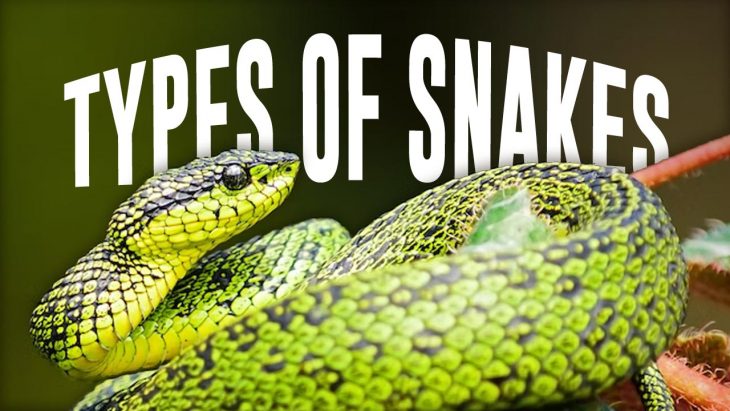
Snakes are some of the most widespread reptiles in the world. In fact, they have a presence on every continent on Earth with the sole exception of Antarctica. Learn more about their variety today with these 50 types of snakes from around the world.
Angel de la Guardia Island Speckled Rattlesnake
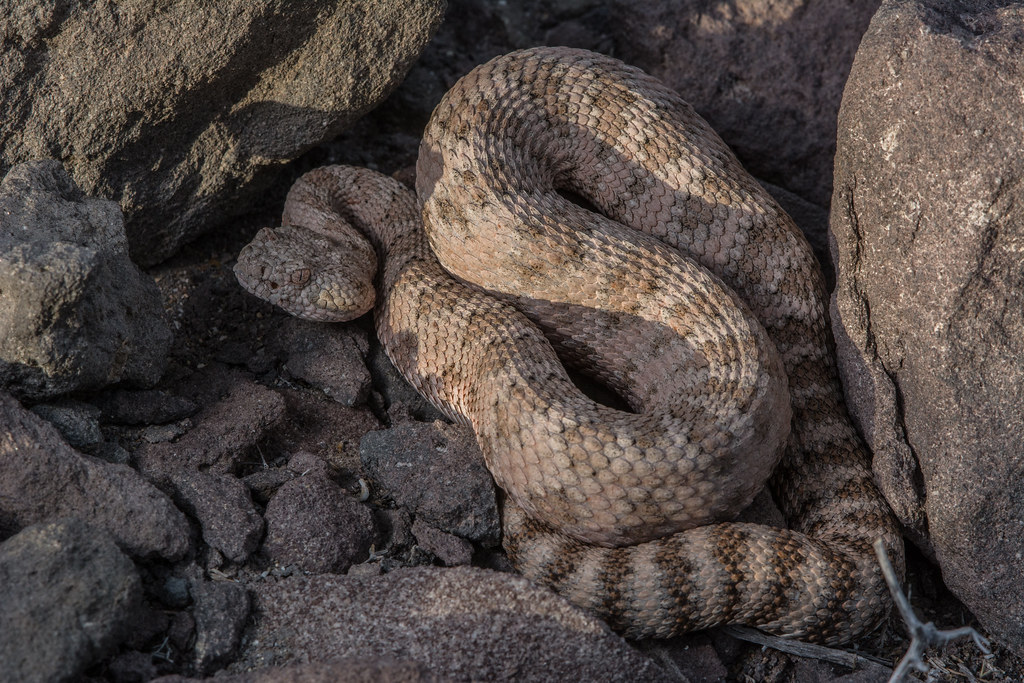
As its name indicates, this venomous snake comes from Isla Ángel de la Guardia in the Gulf of Mexico. It can grow up to 137 cm long, while its coloring depends on the age of the specimen in question. Younger specimens tend to have a pink-cinnamon color with brown or dark brown blotches. In contrast, older specimens have a brown or gray color, while retaining the blotches or speckles that give the species its name. This snake likes to live in rocky areas along the shore, with specimens rarely found past 500 meters from the water.
The Ángel de la Guardia Island speckled rattlesnake has a varied diet, feeding on small birds, mammals, and reptiles on its island. Between its home island’s lack of a permanent human presence and protected status, the Ángel de la Guardia Island speckled rattlesnake maintains a large and stable population. This, in turn, has earned it a conservation status of Least Concern.
Aquatic Garter Snake
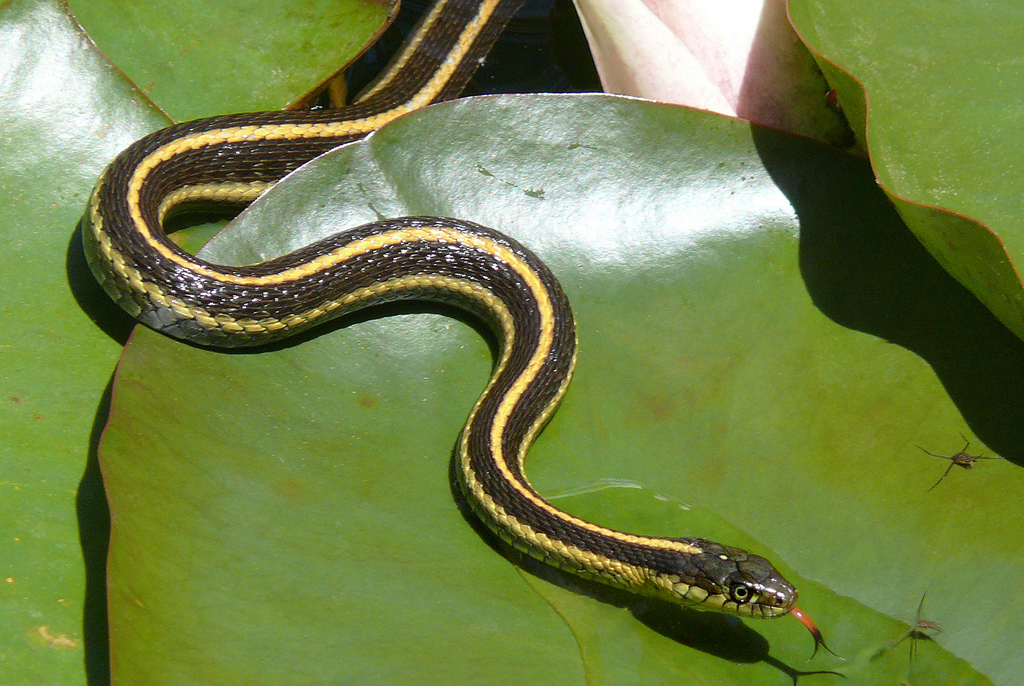
This non-venomous species of snake takes its name from how it usually lives near freshwater bodies like ponds, streams, and lakes. It’s particularly common in marshy woodland areas with plenty of the aforementioned freshwater bodies.
The aquatic garter snake can grow up to 102 cm long. However, its coloring varies greatly between specimens. Some specimens have a pale gray color with dark blotches along the sides of their bodies. Other specimens have a dark brown color instead, with vague blotches over their bodies. Some specimens may even have a largely-uniform black coloring instead. Many aquatic garter snakes have a yellow stripe running down their backs, or around their necks. In contrast, the aquatic garter snake’s belly tends to have less variation in color, typically a shade of white ranging to yellow.
The aquatic garter snake subsists on a diet of small fish, which it can lure to itself by mimicking insect noises. Unlike many other snakes, the aquatic garter snake doesn’t lay eggs, instead bears live young. On average, they can birth up to 12 young at a time, although they may birth broods of as few as three snakes. The aquatic garter snake has a stable population, giving it the conservation status of Least Concern.
Australian Copperhead
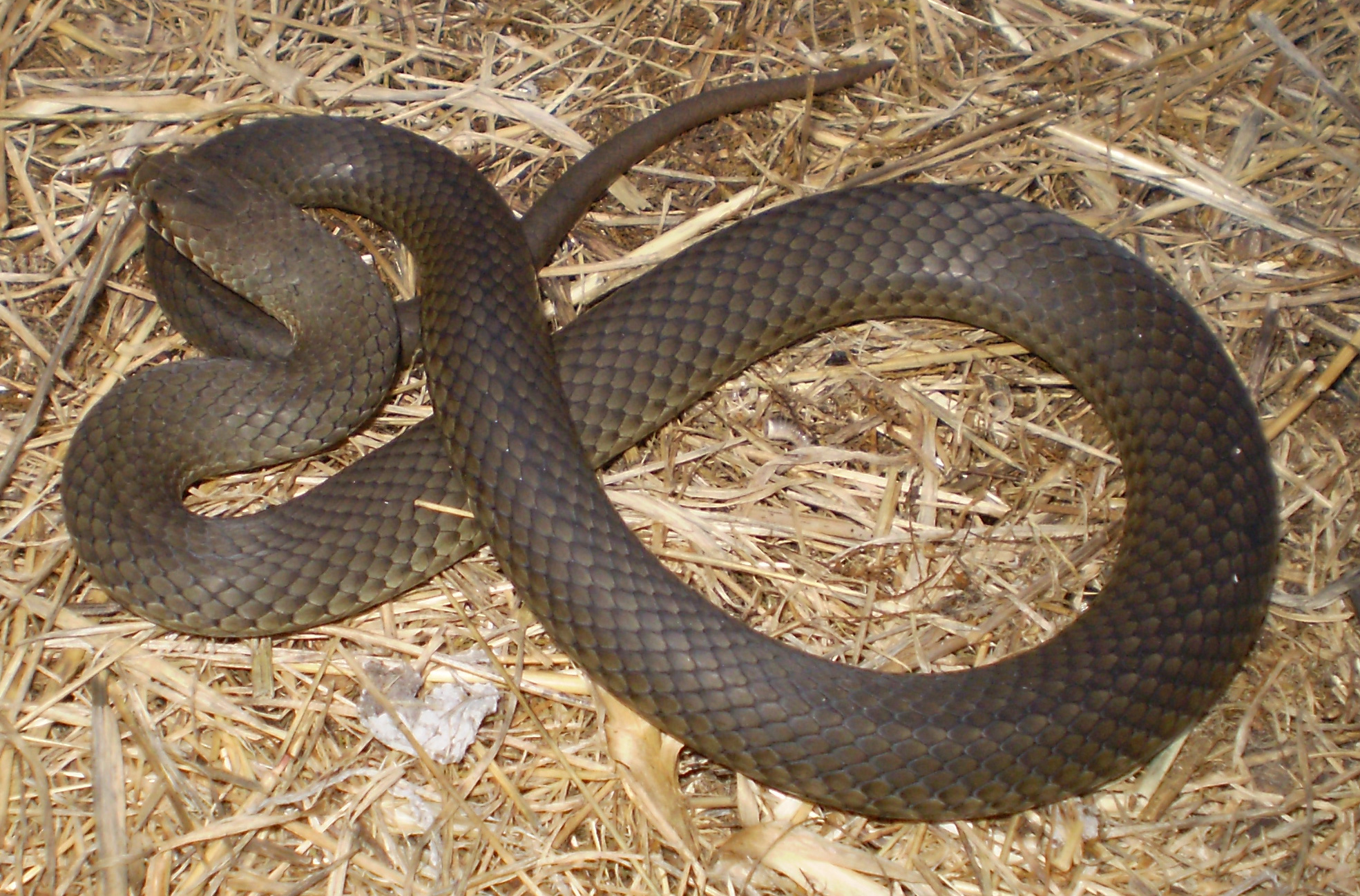
As its name indicates, this type of snake comes from Australia, with three different variants: highland, lowland, and pygmy. Pygmy Australian copperheads make up the smallest kind, growing only up to 60 cm long. They mostly live in the state of South Australia, as well as on Kangaroo Island. The highland Australian copperhead has a longer body, up 1.25 meters, and mostly lives in the mountains of Victoria and New South Wales states. The lowland Australian copperhead has the longest body of them all, up to 1.75 meters, and mostly lives in southern Victoria state, as well as the island of Tasmania.
A venomous snake, Australian copperheads actually have mild venom by the standards of their home continent. This means that even a single bite can still deliver enough venom to kill an adult human without immediate medical attention. That said, Australian copperheads usually void humans, and mostly feed on frogs. They also bear live young instead of laying eggs, with broods of up to 14 young. Currently, the Australian copperhead enjoys a conservation status of Least Concern.
Ball Python
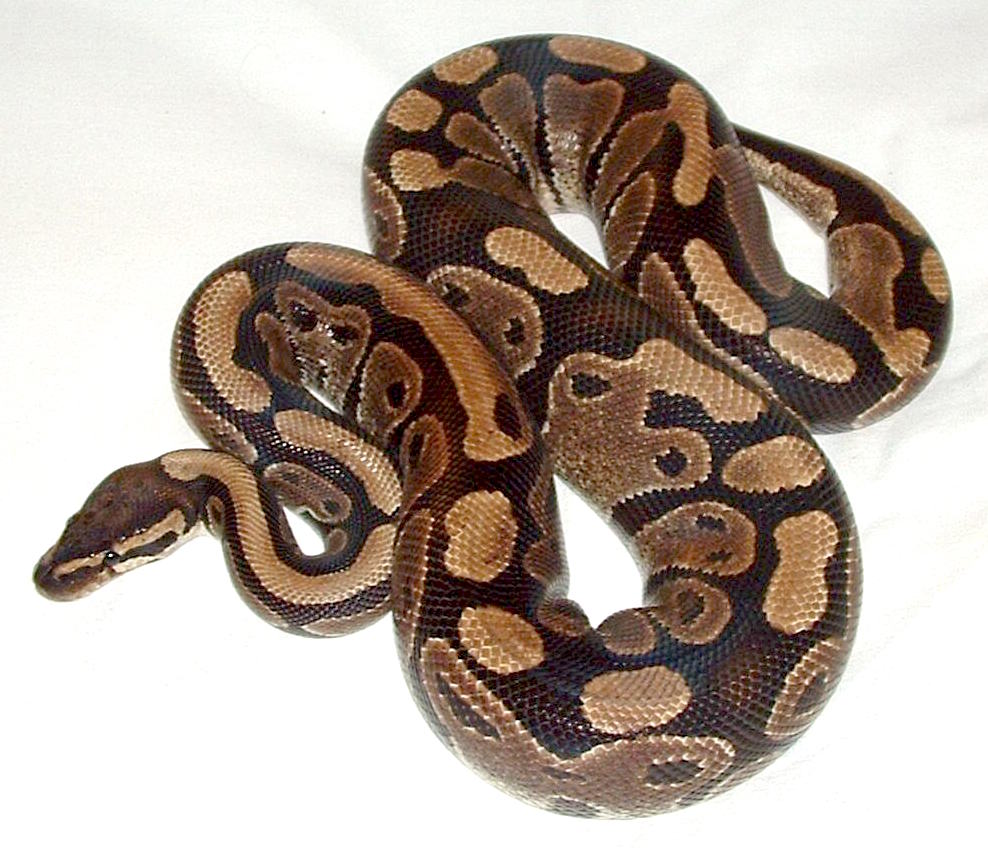
Also called the royal python, this non-venomous snake ranges across West and Central Africa. It gets its common name from its habit of coiling up into a ball whenever it gets stressed or frightened. Together with a docile disposition, the ball python has the reputation of being one of the safest pythons to handle in zoos and nature reserves. It’s also very popular among exotic pet owners worldwide.
The ball python has the distinction of the shortest python in Africa, typically growing up to only around 1.82 meters long. It has a black or dark brown color, marked with light brown blotches down its back and sides. They usually prey on small mammals and birds, with marked preferences for either gender. Males prefer to prey on small birds, while females prefer to prey on small mammals.
Despite its popularity and even non-aggressive character, the ball python currently has a Near Threatened conservation status. Scientists believe that with their appeal and non-aggressive state, poachers heavily target the animal to supply the exotic pet market.
Blackneck Garter Snake
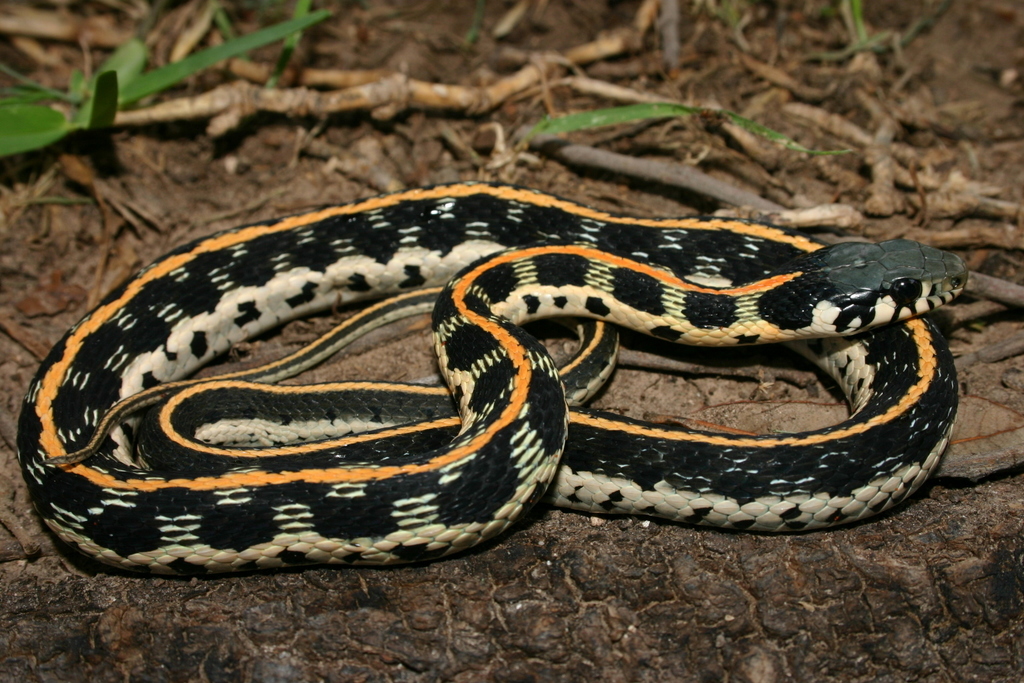
This non-venomous snake mostly lives in the Southwestern USA, while also found south into Mexico and Guatemala. It has two variants, the western and eastern blackneck garter snakes. The western variant can grow up to 107 cm long, while the eastern variant usually only grows up to 51 cm long. They also differ in their habitats, with the western blackneck garter snakes preferring wet areas near freshwater bodies. In contrast, the eastern blackneck garter snakes prefer dry ground, if still near freshwater bodies.
They also differ in their coloring, with the western variant having a dark olive color with an orange-yellow stripe running down its back. It also has a cream or light gray belly. The eastern variant, though, has a dark body with three stripes of light orange or orange-yellow. Both variants feed on small amphibians, fish, and even other snakes. They may also sometimes eat earthworms. The blackneck garter snake currently enjoys a conservation status of Least Concern.
Black-Headed Python
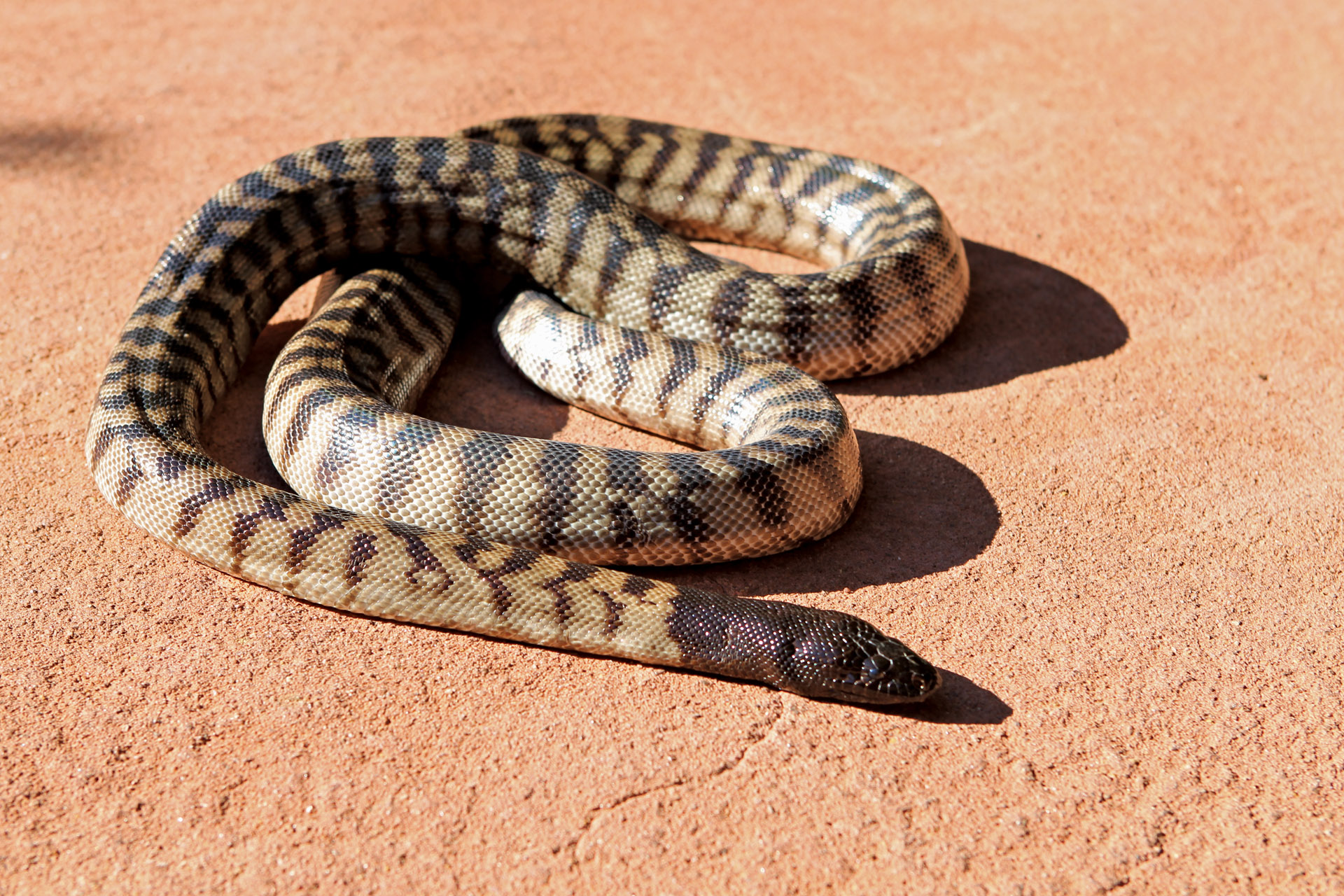
This non-venomous snake comes from Australia and takes its name from the glossy black color of its head. This contrasts with the rest of its body, the color of which varies between shades of black, brown, cream, dark gray, and even gold. Its belly typically has a light color marked with dark spots.
As typical for a python, the black-headed python has a very long body, at least 1.5 meters long and up to 3.5 meters long at maximum. The black-headed has a widespread population across Northern Australia, avoiding only the region’s desert areas. This has contributed to its stable population and conservation status of Least Concern. The black-headed python feeds on its fellow snakes and rarely preys on mammals. Unusually, while a good swimmer, the black-headed python avoids entering the water.
Black Mamba
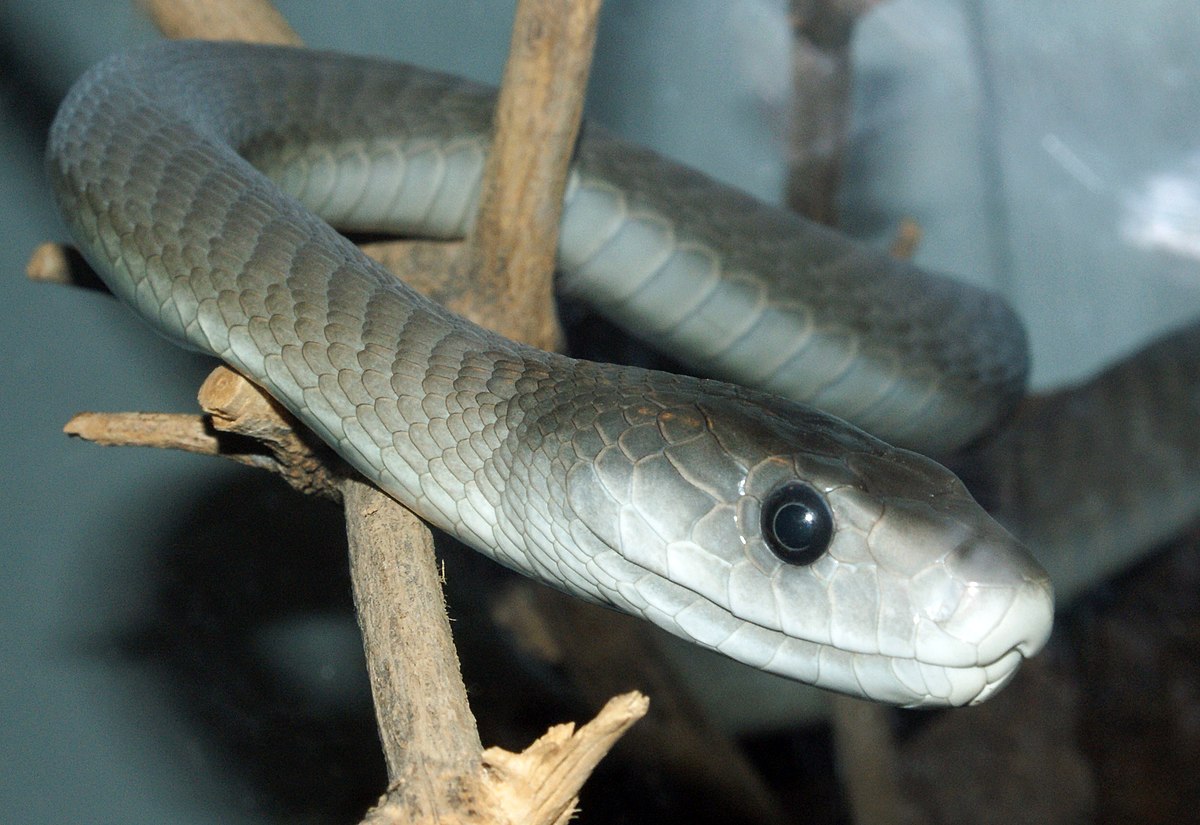
One of the deadliest snakes in the world, this venomous snake comes from the sub-Saharan region of Africa. With a maximum recorded length of 3 meters, it’s also the second-longest venomous snake in the world. Unverified reports also exist of even longer black mambas, with bodies of up to 4.5 meters long. Its color varies between shades of gray and dark brown, with younger specimens having a lighter color that darkens with age. The black mamba has a black mouth, though, from which it gets its name.
Black mambas have an aggressive attitude, and when they bite, they do so many times. Between multiple bites and the powerful neurotoxins in its venom, a black mamba can kill a person in just 10 minutes. Despite its aggressiveness, though, the black mamba typically avoids humans, and will only attack when forced into a corner. Otherwise, the snake would sooner run and hide. The black mamba’s wide range of habitats gives it a stable population and a conservation status of Least Concern.
Black Rat Snake

A non-venomous snake common across North America, it takes its name from the near-uniform black color of adults. In contrast, juveniles of the species have a gray body with brown blotches over its length. Black rat snakes can grow up to 183 cm long, with a maximum recorded length of 398 cm. This actually makes them the longest snakes in Canada.
They mostly feed on small mammals, as well as amphibians and birds. Their wide range of habitats across North America has given black rat snakes a stable population. This, in turn, has given them a conservation status of Least Concern. It’s also made them a staple of the legal exotic pet trade in the USA. Breeders have deliberately bred mutations into tame black rat snakes to give them a wider range of colors than in nature. Pale or even albino black rat snakes prove especially popular breeds.
Black Whip Snake
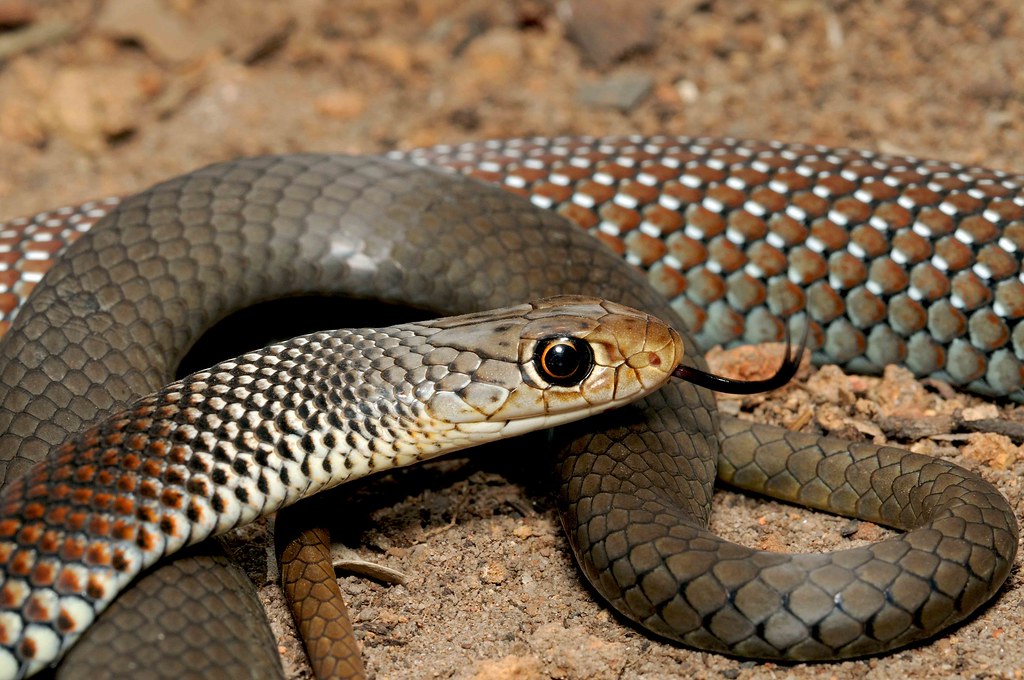
Also called the lesser black whip snake, it is a venomous snake native to Australia. It can grow up to around a meter in length, with a coloring that varies between shades of gray, dark brown, and black. It also features patterns of black dots and white dashes running over its body. In contrast, its belly has a gray color that shifts to red towards and under its tail.
The black whip snake typically feeds on smaller reptiles. Its wide range of habitats across Australia has given it a stable population and a conservation status of Least Concern. It also makes them more likely to encounter humans, with larger specimens of the black whip snake especially dangerous.
Boa Constrictor
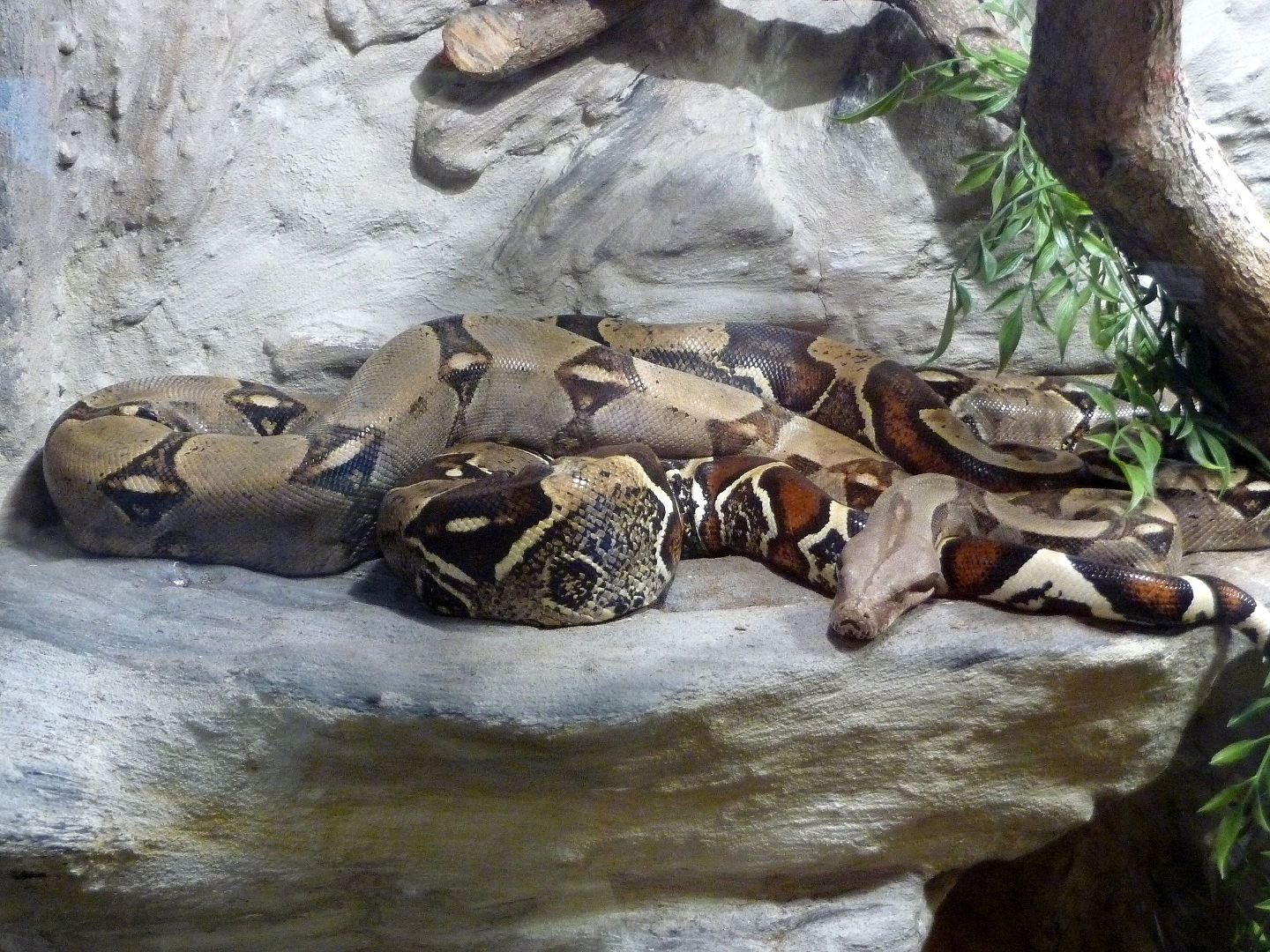
Also called the red-tailed boa or the common boa, the boa constrictor mostly lives in South America. Various islands in the Caribbean Sea also feature populations of the boa constrictor. A non-venomous snake, the boa constrictor has a very long body, with a length of up to 3.96 meters. It’s also quite heavy for a snake, weighing up to 27 kg, with rare specimens able to weigh up to 45 kg. A boa constrictor’s color varies between regions, but typically features shades of brown, cream, and gray. They also have brown or red-brown markings that grow in size towards their tails, hence the alternative name of red-tailed boa.
Boa constrictors typically feed on medium-sized mammals and birds, with animals as big as monkeys and even pigs being staples in a boa constrictor’s diet. The boa constrictor has a stable population thanks to its wide range of habitats and gives it a conservation status of Least Concern.
Broad-Banded Copperhead

A venomous snake native to the Southern USA, it gets its name from broad bands of dark brown running down its body. These contrast with the tan background color of its skin, with the bands growing narrower towards the middle of the body. This gives the snake an unusual hourglass pattern. Juveniles of the species also have green or yellow tails that they use as lures to help them hunt prey.
Broad-banded copperheads typically grow up to 90 cm long and hunt various prey ranging from small mammals, birds, and reptiles, to insects like caterpillars. Their venom also features hemotoxins instead of neurotoxins, which work by destroying the blood instead of the nervous system. While mild compared to the venom of other snakes, the real danger of a broad-banded copperhead’s venom lies in its current lack of an antidote. However, cottonmouth antivenom has since proven an effective substitute.
Bullsnake
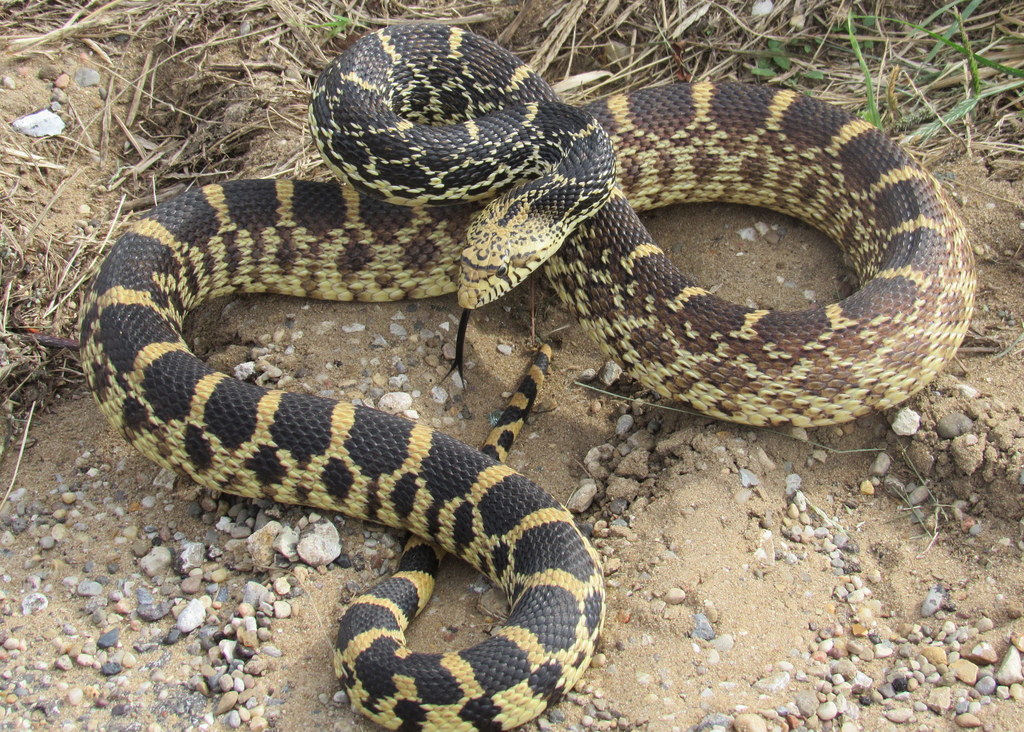
One of the longest snakes in North America, bullsnakes can grow up to an average length of around 2.44 meters. It gets its name from its unique hiss, which scientists have compared to a bull’s grunt. It can also grow quite heavy, averaging around 1.5 kg, with a maximum recorded weight of 4.5 kg. Bullsnakes usually have a yellow color, marked with blotches that vary in color between black, brown, red, and white.
The bullsnake lives across a wide range of habitats ranging from Canada in the north to Mexico in the south. A non-venomous snake, the bullsnake usually preys on small mammals, but they also sometimes prey on other snakes, including rattlesnakes. In fact, wildlife experts discourage the hunting of bullsnakes, as they help control the rattlesnake’s wild population.
Burmese Python
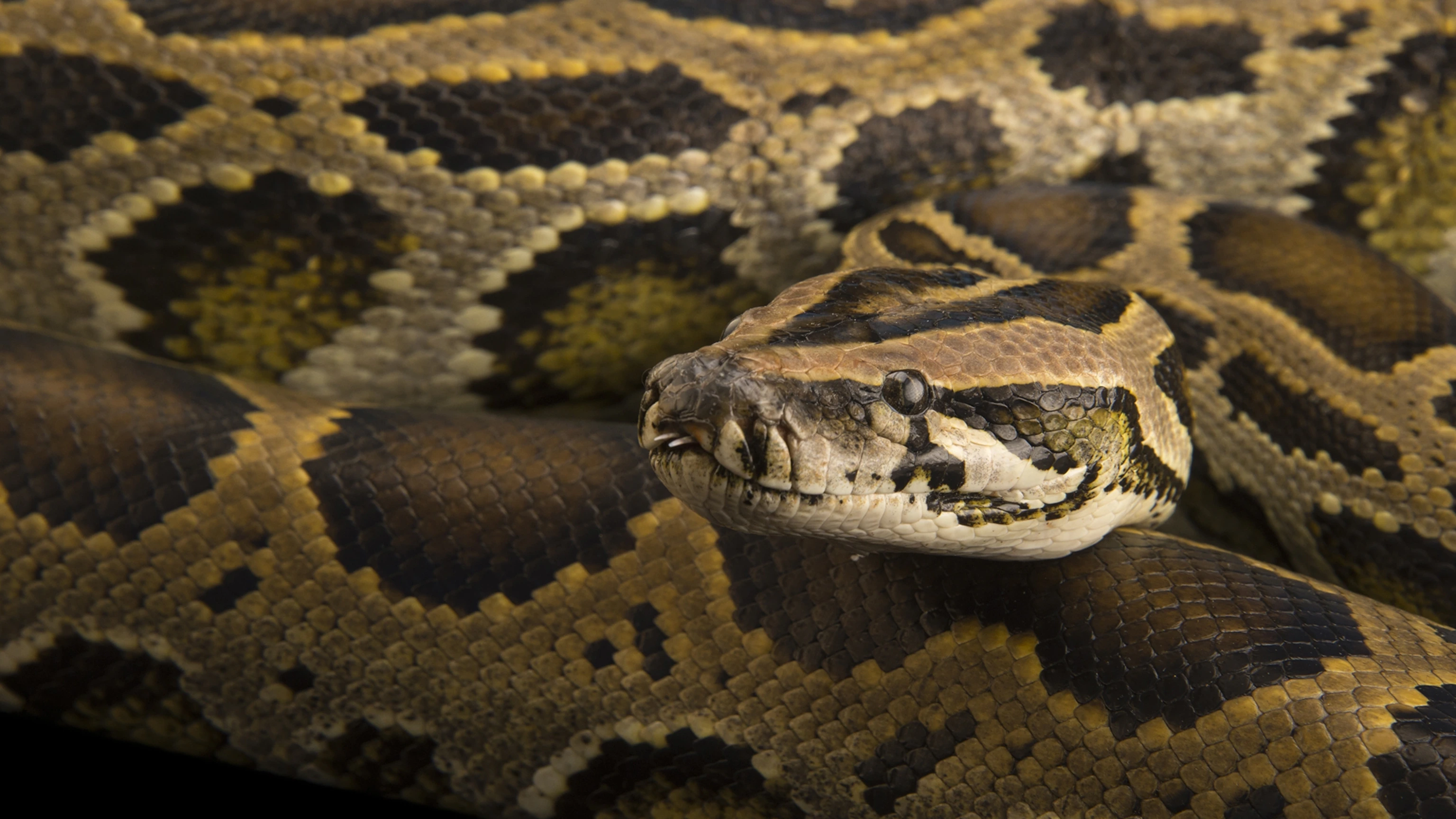
As its name indicates, this non-venomous snake comes from Burma, although it’s actually quite common across Southeast Asia. They also have a presence in Florida, where they’re considered an invasive species. This resulted from their unintentional introduction into the region as part of the exotic pet market in the late 20th century.
One of the longest snakes in the world, the Burmese python can grow up to 5 meters long. Unconfirmed reports also exist of specimens with lengths of up to 7 meters long. It also has a varied diet, primarily of birds and mammals, and also amphibians and reptiles. In fact, the Burmese python’s size allows it to prey on domesticated animals like chicken and other kinds of poultry. They may also prey on pet cats and dogs, which has led to it becoming seen as a pest in Southeast Asia.
That said, they’re also bred in captivity, whether as pets or to harvest their skin to turn into leather. Wild Burmese pythons also get hunted for the same reason. Together with the gradual loss of habitat thanks to human development, this has left the Burmese python with a conservation status of a Vulnerable Species.
Bushmaster
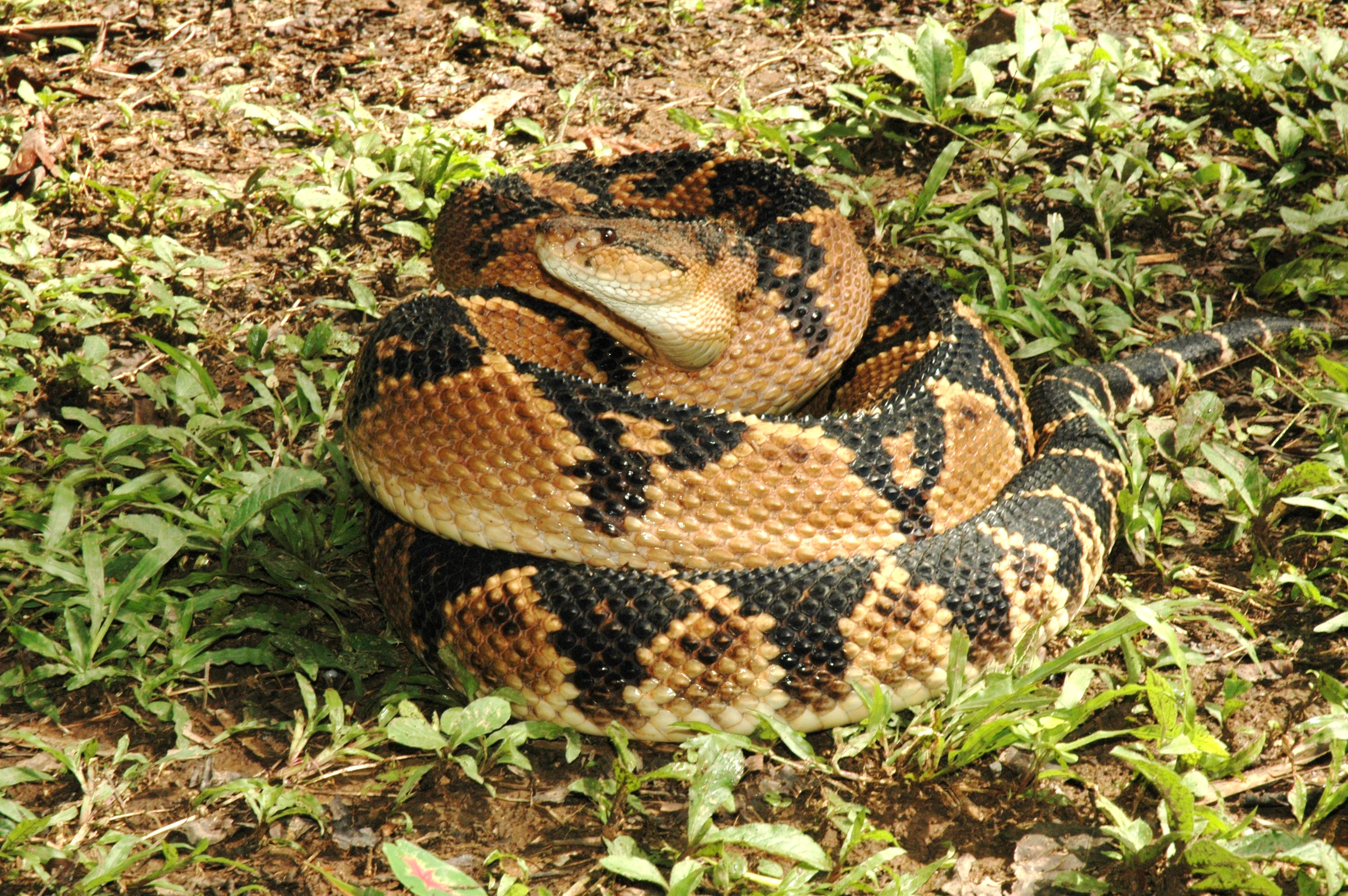
One of the most venomous snakes in the world, this has resulted in the snake’s alternative name, which is Lachesis. This is after one of the Three Fates in Greek mythology, who determines the length of a person’s lifespan.
A bushmaster can grow up to 3 meters long, with some specimens even reaching lengths of 4 meters. They possess powerful venom, thanks to it possessing different kinds of toxins. These include plasminogen, which destroys blood vessels while also forcing blood to clot inside the body. It also contains certain enzymes that kill cells while also further damaging the blood vessels. Other enzymes destroy muscle fibers, cause uncontrolled swelling, and even force the body to target and destroy its own nerves. This cocktail of toxins means that even a single bite from a juvenile bushmaster can kill an adult human. Unfortunately, all bushmasters tend to have aggressive dispositions and will bite multiple times to inject as much venom as possible.
Butler’s Garter Snake
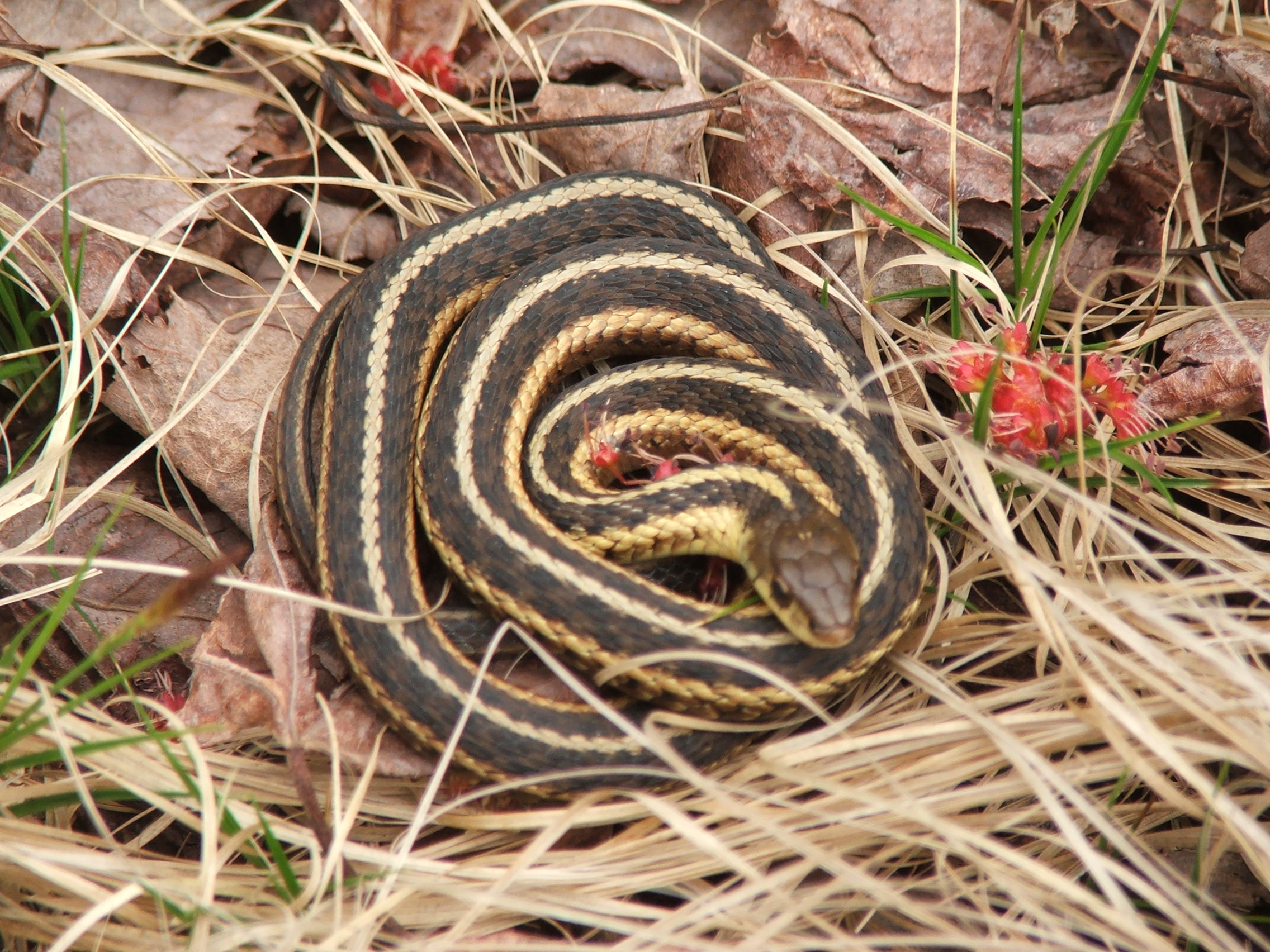
A non-venomous snake native to North America, it takes its name from ornithologist Amos Butler. A very small snake, Butler’s garter snake at most grows up to 51 cm long. Its color ranges from olive-brown to black, with a trio of yellow or orange stripes running down its back. It may also have rows of black dots running down between the spines.
Butler’s garter snake prefers open and grassy areas, and thanks to its small size, subsists on a diet of invertebrates. This mostly includes earthworms, as well as leeches. They may also feed on smaller vertebrates, like frogs and salamanders. Butler’s garter snake currently has an uncertain conservation status. On one hand, international organizations list the species as Least Concern. However, both the USA’s Indiana state and Canada’s Ontario state list it as Endangered instead.
Central African Rock Python
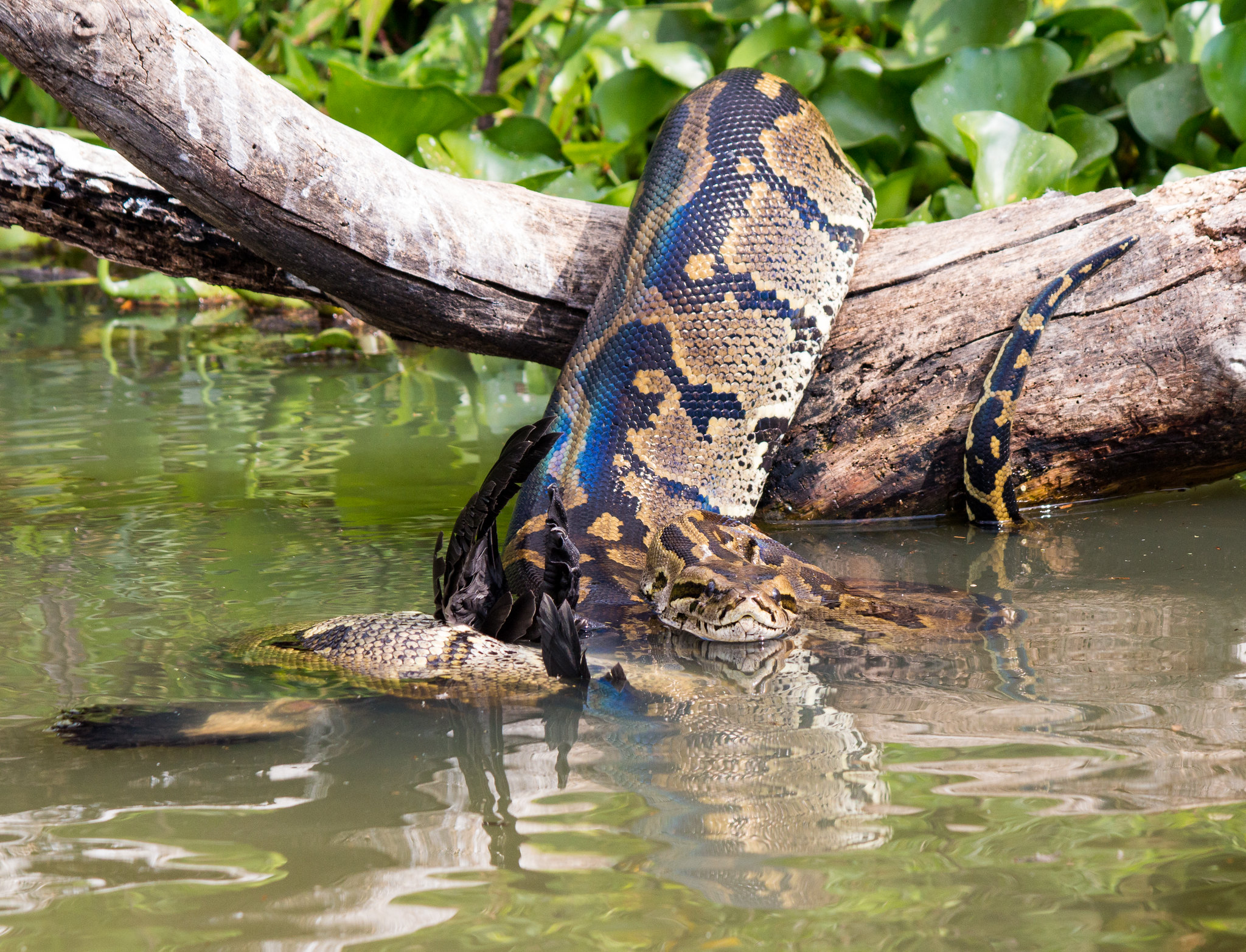
The largest snake in Africa, despite its name it’s not limited to Central Africa, ranges across the whole sub-Saharan region. It usually grows up to around 3.53 meters long, with some specimens able to grow up to 4.8 meters. Scientists have also documented rare specimens with a length of 6 meters, along with unconfirmed reports of even longer specimens.
Central African rock pythons have bodies covered with blotches of varying colors, such as brown, chestnut, olive, and yellow. These blotches merge together to give the snake an irregular color scheme that varies from animal to animal. However, all Central African rock pythons have white bellies.
Thanks to their large size, Central African rock pythons have a varied diet, including large animals. These include antelopes, crocodiles, monitor lizards, monkeys, and warthogs. They may also feed on pet cats and dogs from human settlements. Scientists have also found evidence they prey on the cubs of other predators, such as cheetahs and lions. However, scientists note that this happens rarely.
Central African rock pythons currently have a Near Threatened conservation status, thanks to human development of their habitats. They’re also targeted by hunters, who harvest their skin to turn into leather.
Chasen’s Mountain Pit Viper

Also known as the Kinabalu brown pit viper, this alternative name references its home on Mount Kinabalu in Northern Borneo, Malaysia. Its common name, though, honors Frederick Chasen, who served as curator of Singapore’s Raffles Museum in 1931. Chasen’s mountain pit viper typically grows up to 65 cm. It usually has a color of either dark brown or red-brown, with dark-colored crossbands running down its body. These bands have a broken pattern near the snake’s head, but grow regular towards its tail. In contrast, its belly always has a yellow and gray color. The snake lives only on Mount Kinabalu, within its submontane forests at altitudes of between 915 meters and 1.55 km.
Common Garter Snake

A venomous snake native to North America, common garter snakes have become known as the state reptile of the US state of Massachusetts. Small reptiles, common garter snakes only grow up to 1.2 meters long, and even then it’s rare for them to grow so much. Common garter snakes typically feature a color of black, brown, or green, along with yellow stripes
Their small size also makes their venom less dangerous to humans than those of other snakes. At most, it’ll cause only itching and swelling around the bite area, as well as a burning feeling. That said, it’s strong enough to kill the snake’s usual prey, such as amphibians and small mammals. It also makes them immune to the toxins of other venomous animals, like toads and newts.
Scientists have also discovered that common garter snakes can actually absorb the toxin of any newts that it eats. The toxin stays in its body, making it poisonous to anything that might eat the snake. In fact, would-be predators already seem to have learned this, as they tend to avoid preying on the common garter snake.
Corn Snake

A non-venomous snake, it has a strong resemblance to various copperhead species, which unfortunately causes it to get hunted and killed out of fear. The corn snake gets its name from its habit of living near silos and other places which store corn and grain. The snake does this to take advantage of how rats and similar small mammals try to get at the grain. This, however, puts it in a position to encounter humans. That said, scientists consider this as a beneficial form of relationship, with the snakes serving as a form of environmentally-friendly pest control.
Corn snakes typically grow up to 1.82 cm long, with pale brown or pink coloring. Their bodies also feature crossbands going down their length, varying in colors like light brown and pink. This also sometimes makes it hard to make out the bands against the rest of the corn snake’s skin.
Cottonmouth
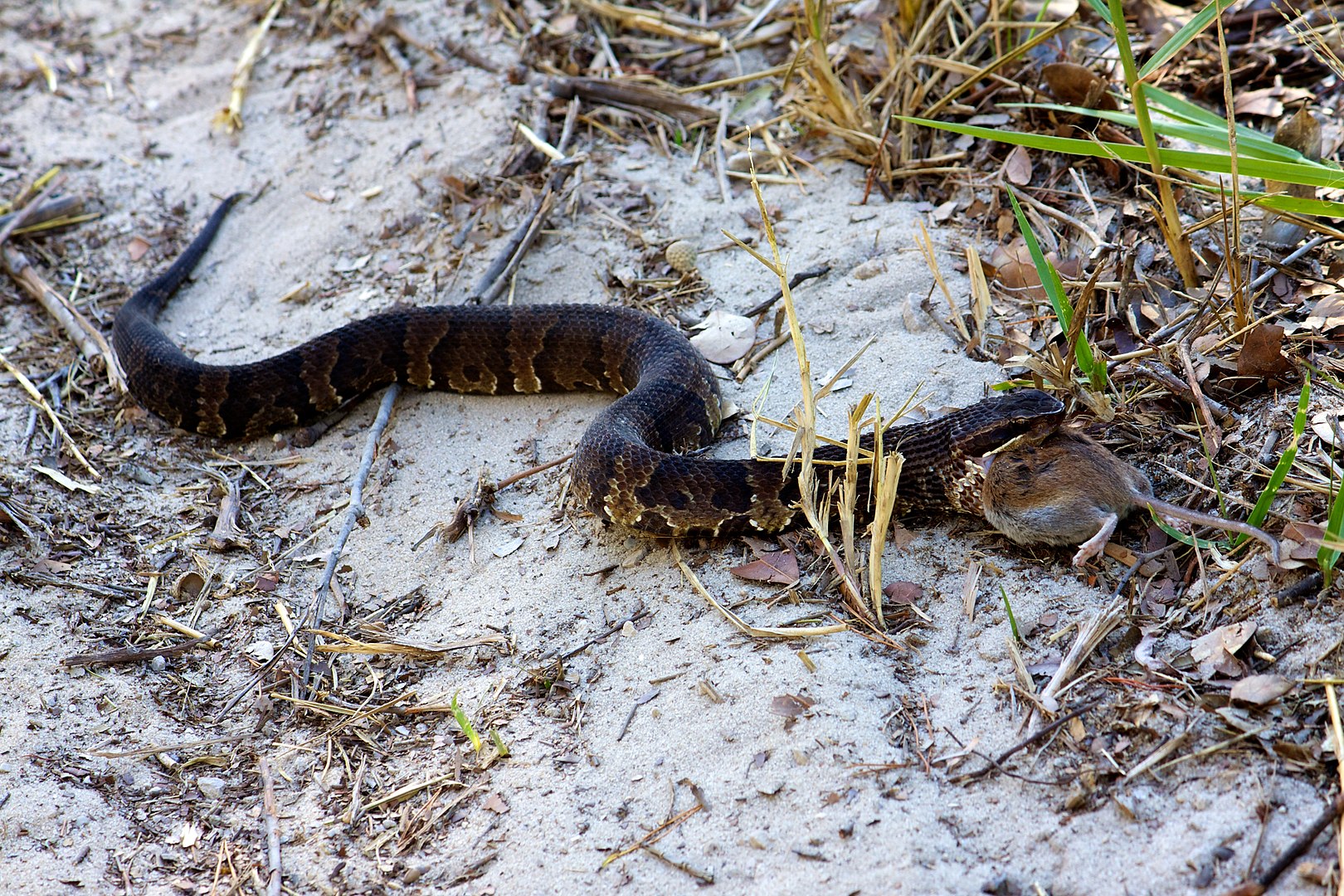
One of the few semi-aquatic pit vipers in the world, the cottonmouth mostly lives in the Southeastern USA. It’s also one of the longest pit vipers in the world, growing up to a length of 90 cm, with rare specimens growing up to twice that length, at 1.8 meters.
Most cottonmouths have largely-black skin, with rare specimens having other colors. These include brown, gray, and even yellow-green, with dark brown or black bands running down its body. The bands tend to fade with age, with the oldest cottonmouths seeming to have no bands at all. A cottonmouth’s belly, though, universally has a white or yellow-white color, marked with dark spots. Similarly, its head usually has a brown color.
Cottonmouths have one of the strongest venoms among snakes, composed of cytotoxins that simply destroy tissue. While deaths rarely occur, even with antivenom, heavy scarring usually results from a cottonmouth bite. In some cases, the tissue damage proves so great that doctors have no choice but to amputate.
Cottonmouths today suffer from the loss of habitat loss thanks to human development. Despite this, however, they maintain a stable population. International organizations thus label them as of Least Concern. The state of Indiana in the USA, though, sees them as an endangered species.
Death Adder

A venomous snake native to Australia, it’s also one of the deadliest snakes in the whole world. They can strike very quickly, and in fact, they’re the fastest striking snakes in Australia. Their venom works quickly, a powerful neurotoxin that paralyzes the body and kills the victim by keeping them from breathing. Without medical treatment, humans die within six hours of a death adder’s bite.
Death adders typically grow up to 1 meter long and have bodies featuring alternating bands of red, brown, and black. In contrast, their bellies feature a uniform gray, pink, or white color. Death adders enjoy a stable population, giving them a conservation status of Least Concern.
Ironically, despite their stable population and deadly venom, they’re also badly affected by invasive cane toads. Cane toads prey on young death adders, while adult death adders who prey on the toads find themselves poisoned by the toads’ own venom.
Diamondback Water Snake

A non-venomous snake native to North America, it mostly lives in the Central USA and ranges south to Mexico. It typically grows up to 1.22 cm long, with rare specimens able to grow as long as 1.8 meters. Diamondback water snakes have brown or green skin, with black net-like patterns forming diamond shapes over their bodies. They also feature dark-colored bars along their sides. In contrast, their bellies have a yellow or light brown color, marked with black blotches.
As their name indicates, diamondback water snakes like to live near water, such as in swamps around ponds, rivers, and streams. Their appearance also gives them a passing resemblance to venomous snakes, such as rattlesnakes. This has unfortunately made them the target of preventative killings by humans. Despite this, however, diamondback water snakes have a stable population, rendering them a conservation status of Least Concern.
Eastern Copperhead
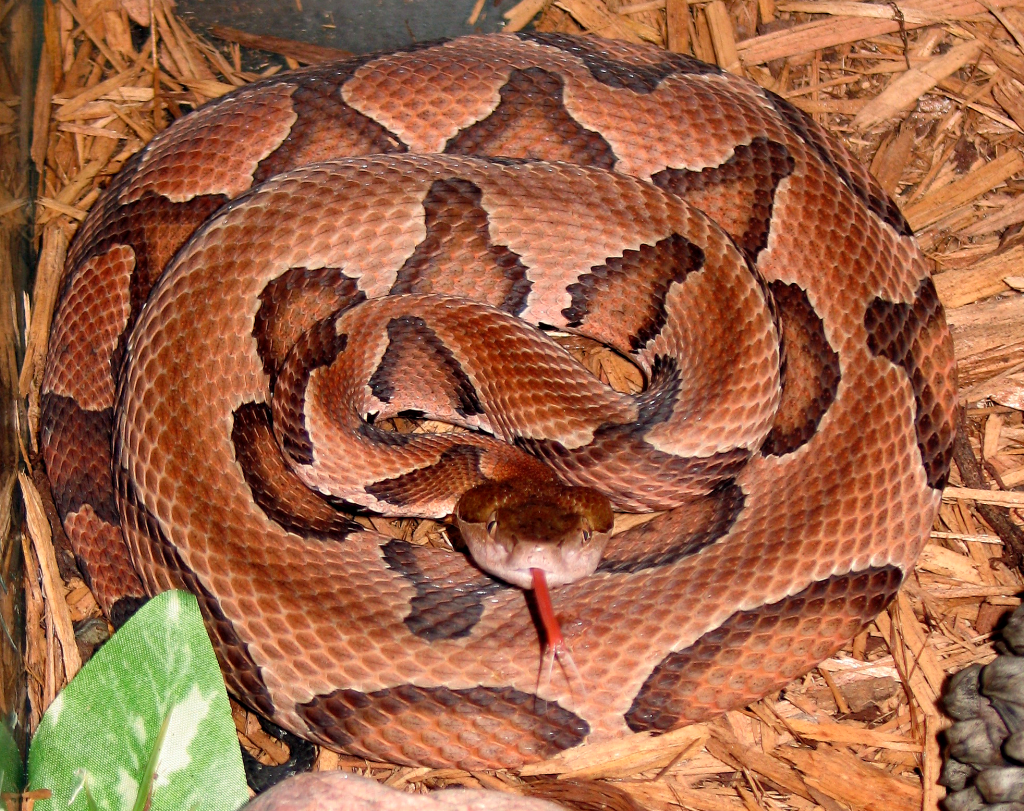
A venomous snake native to North America, it lives across most of the Eastern USA, with the exceptions of Florida and Northern New England. They usually grow up to 95 cm long, with only rare specimens growing up to or longer than 1 meter. They also have light brown or pink skin that darkens towards their heads, along with crossbands running down their bodies. These bands usually have a light brown or pink color that darkens while running towards the sides of the snake’s body. An eastern copperhead’s belly usually has a paler color than the rest of its body, with one to three crossbands towards its tail.
Eastern copperheads also have surprisingly weak venom, the weakest out of all pit vipers, in fact. They’re also not very aggressive, and when biting out of self-defense, will usually deliver a “dry bite” without any venom as a warning. It’s only when the animal or human that disturbed them refuses to leave will the snake start injecting venom in succeeding bites. Eastern copperheads enjoy a stable population, giving them a conservation status of Least Concern.
Eastern Diamondback Rattlesnake
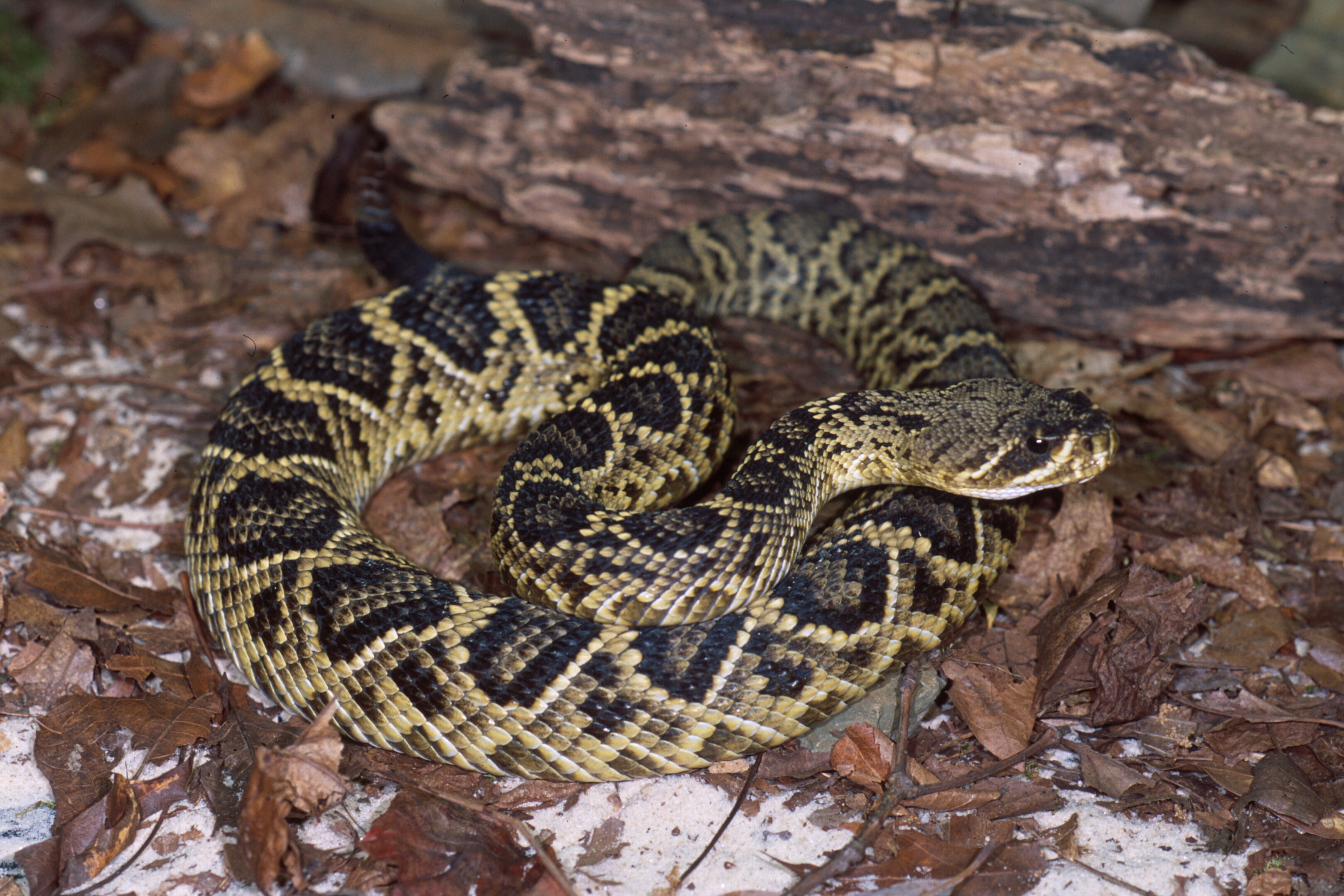
The largest rattlesnake of them all, it’s also one of the largest venomous snakes in the Americas, where it lives in the Southeastern USA. Eastern diamondbacks typically grow up to 2.1 meters long, with rare specimens able to grow as long as 2.5 meters. They’re also one of the heaviest snakes in the world, averaging around 2.3 kg, and going up to 5.12 kg. Scientists have also recorded rare specimens with a weight of up to 6.7 kg.
Eastern diamondbacks tend to have brown, brown-gray, olive, or yellow-brown color, overlaid with dark brown or black diamond-shaped markings. These markings shift from diamond to crossbands towards the snake’s tail. In contrast, an eastern diamondback’s belly has a yellow or cream-colored belly with dark markings along its sides.
Eastern diamondbacks are some of the most dangerous venomous snakes in North America. Even with treatment, fatality rates reach up to an estimated 30%. A venom of one has a mix of toxins that damages blood vessels and destroys platelets. The venom also includes proteins that damage heart tissue, which can cause heart failure.
Eastern diamondbacks generally have a Least Concern conservation status, but they’ve also suffered localized extinctions. This is because of preemptive extermination programs to keep the snakes from biting people, such as in North Carolina.
Eastern Garter Snake
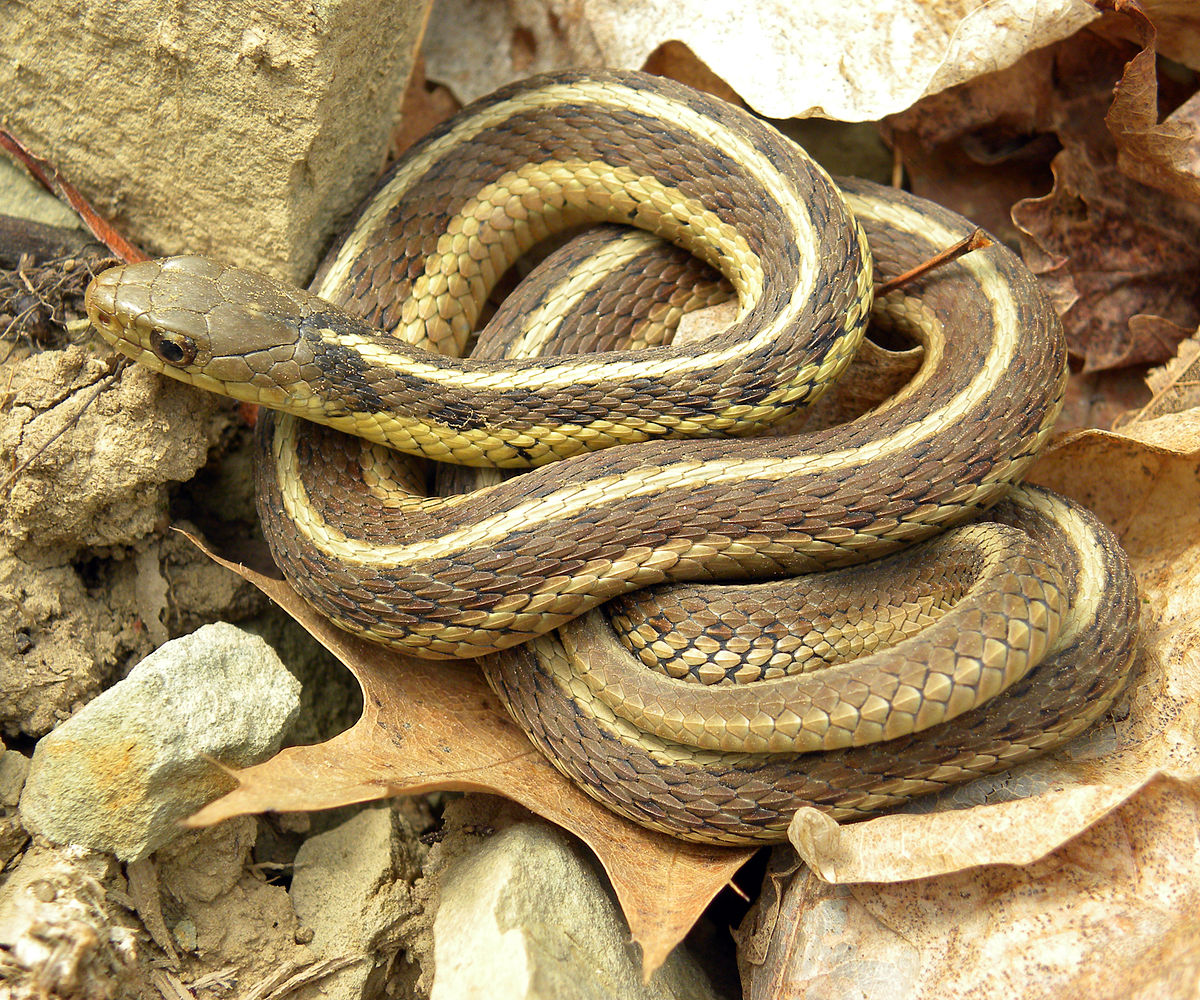
A non-venomous snake native to North America, they live across the eastern part of the continent from Ontario and Quebec in the north to the Gulf of Mexico in the south. Animal guides in New England even describe the eastern garter snake as the most common snake in the region. This contributes to them having a Least Concern conservation status.
Like all garter snakes, the eastern garter snake has a very small size, growing on average up to only 66 cm long. That said, the largest recorded specimen thus far of this snake did manage to grow up to 1.24 meters long. Eastern garter snakes like to live in grassy and stony areas, although some live in wetlands. They’ve also adapted to live in urban areas, making them surprisingly common in towns and cities.
Eastern garter snakes commonly avoid humans and will run rather than bite. That said, bites do happen, and while eastern garter snakes have no venom, their saliva can cause allergic reactions in a small number of victims.
Eastern Milk Snake

Also called the checkered adder, its bright and vivid colors mean it sometimes gets mistaken for a venomous snake when it’s not. A native of North America, the eastern milk snake lives in both Canada and the USA. They populate the areas from Maine and Ontario in the north to Alabama and North Carolina in the south.
Eastern milk snakes usually grow up to around 91 cm long, although scientists have recorded specimens as long as 1.32 meters. A skin of one has an alternating pattern of red-brown and white bands edged in black, while the belly has an irregular pattern of black and white markings. Its small size, non-venomous nature, and docile character make the eastern milk snake a staple of the exotic pet trade in the USA.
Eastern Racer
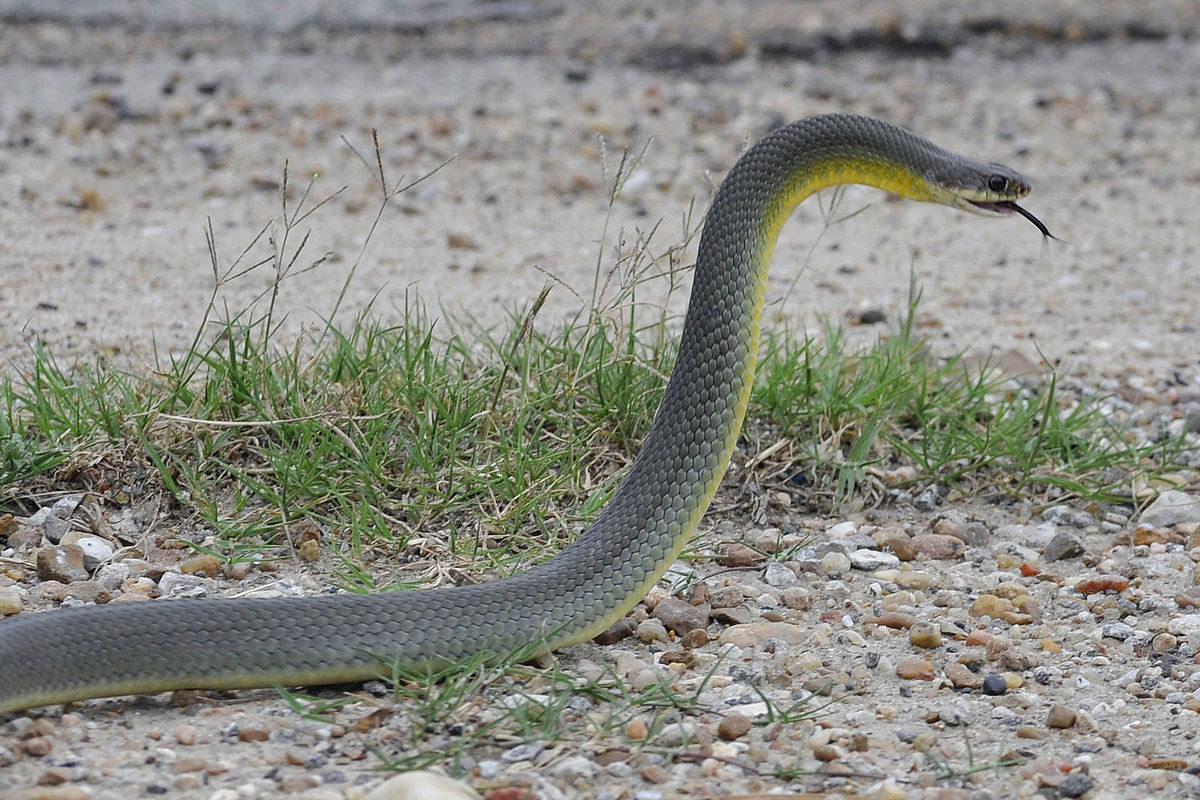
These snakes take their name from their movement speed of up to 5.6 kph, making them some of the fastest snakes in the world. A non-venomous snake common in North and Central America, eastern racers have a presence in Canada, the USA, Mexico, Guatemala, and Belize. In fact, they’re the most common snakes in Florida and have the distinction of Ohio’s state reptile. Their wide range of habitats and stable population all contribute to their Least Concern conservation status.
Eastern racers usually grow up to around 1.52 cm long, although scientists have confirmed rare specimens of up to 1.85 meters long. They usually have uniform coloring, including black, blue, brown, and green. This also gives them their alternative name of black, blue, brown, and green racers. Some sources also substitute “runner” for “racer”. In contrast to the rest of their bodies, though, eastern racers have pale bellies. Similarly, juvenile eastern racers have dark blotches over their bodies which fade as they grow older.
Fea’s Viper
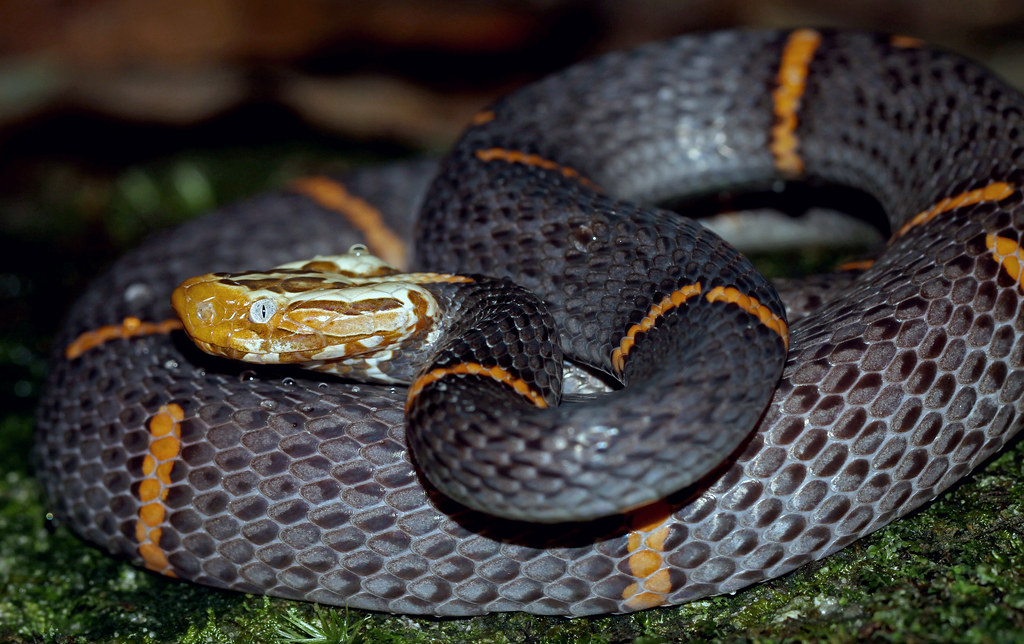
Described by scientists as “the most primitive of the vipers”, Fea’s viper takes its name from Italian explorer Leonardo Fea who discovered it in the late 19th century. They live across South and Southeast Asia, ranging from Northern Vietnam through Southern China to Myanmar and Tibet. In particular, they like to live in the mountainous areas of those regions, typically at altitudes of around 1 km above sea level.
Fea’s viper grows fairly short, with the longest specimens at only around 77 cm long. Most of their bodies have a shiny, blue-gray or black color, with widely-spaced white-orange crossbands. Their bellies, though, have an olive-gray color marked with light spots. Their heads also contrast with the rest of their bodies, with an orange or yellow color banded with gray markings.
Fea’s viper primarily feeds on small mammals and possesses an unusual venom that scientists still aren’t clear about. They know that the venom partly works by paralyzing the muscles, but they’ve also noticed that the Fea’s viper’s venom isn’t purely a neurotoxin. Studies into the mysteries of the snake’s venom continue to this day.
Florida Cottonmouth
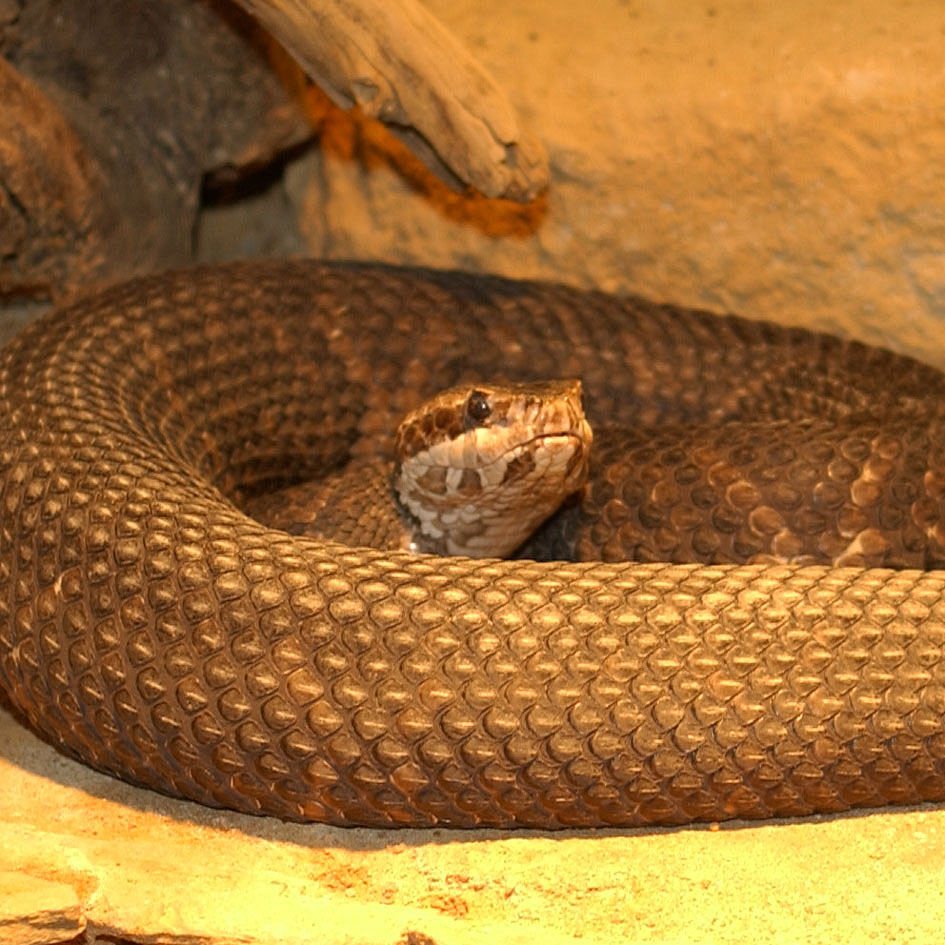
As its name indicates, this snake comes from and mostly lives in the US state of Florida. It has a similar appearance to non-venomous water snakes, which can prove dangerous as the Florida cottonmouth has very powerful venom. It contains hemotoxins that work by destroying the blood, resulting in a 17% fatality rate even with immediate medical attention.
A fairly large snake, the Florida cottonmouth typically grows up to 1.89 meters long. Its body has an olive-brown or dark brown color that shades black, along with dark markings running down its body. The skin darkens as the skin grows older, with many adults losing their markings over time. The head, though, retains a pair of stripes on its cheeks, with white markings above and below.
Golden Lancehead
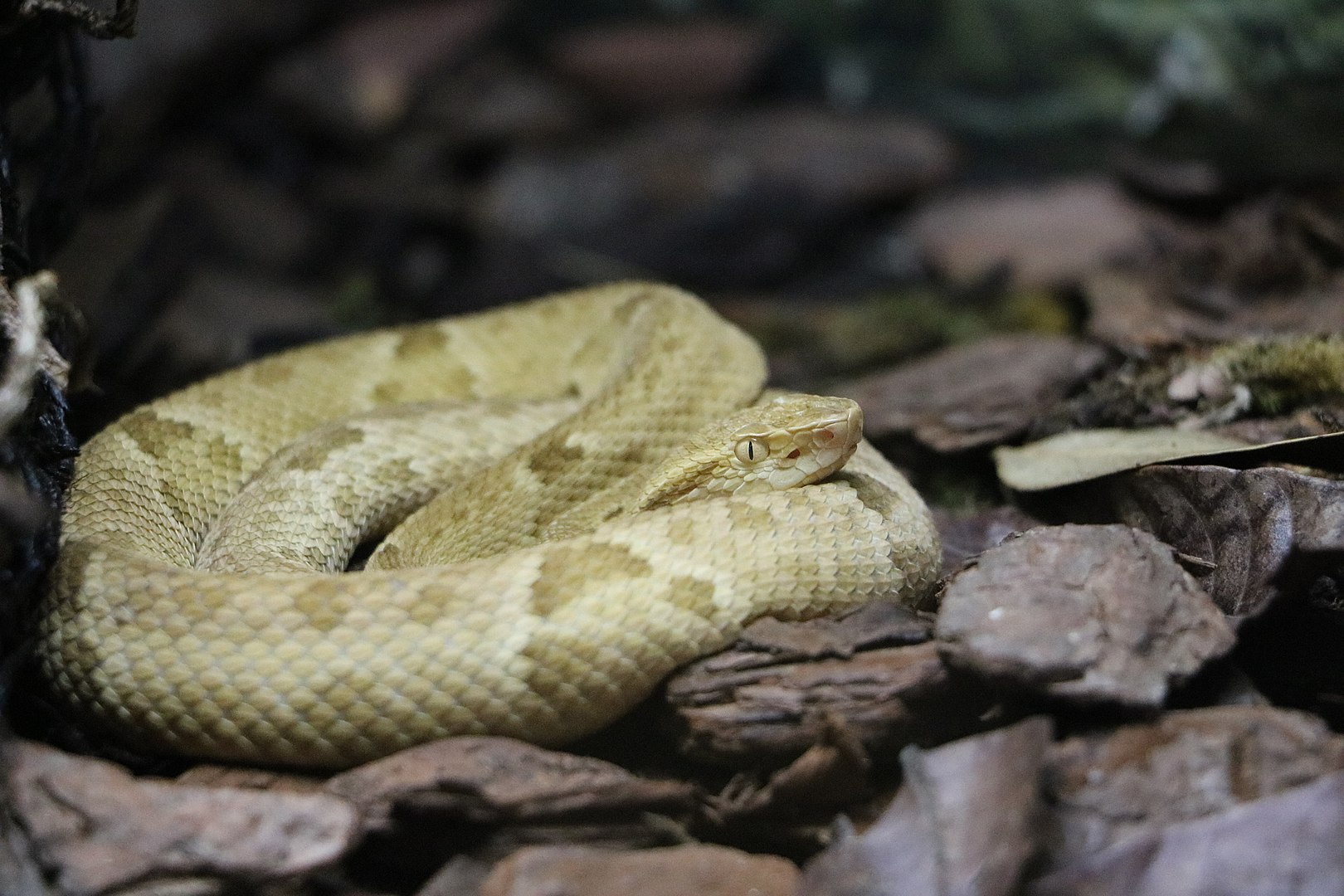
This venomous snake lives only on Snake Island off the coast of Brazil near Sao Paulo. It gets its name from its gold-colored skin marked with pale blotches going down its body. It also refers to the snake’s head, which has an elongated shape that narrows to a point, like the head of a lance or a spear. Unlike most snakes, the golden lancehead’s belly doesn’t contrast much with the rest of its body’s color. The golden lancehead typically grows up to 90 cm long, with rare specimens growing up to 1.18 meters long.
Its isolation on Snake Island has also resulted in the golden lancehead’s venom becoming specialized. In particular, it’s more effective against other snakes, reptiles, and birds than against mammals. However, the snake’s isolation also means that no record exists of a human getting bitten by a golden lancehead. This means it’s not actually clear how badly the snake’s venom would affect a human.
Green Anaconda
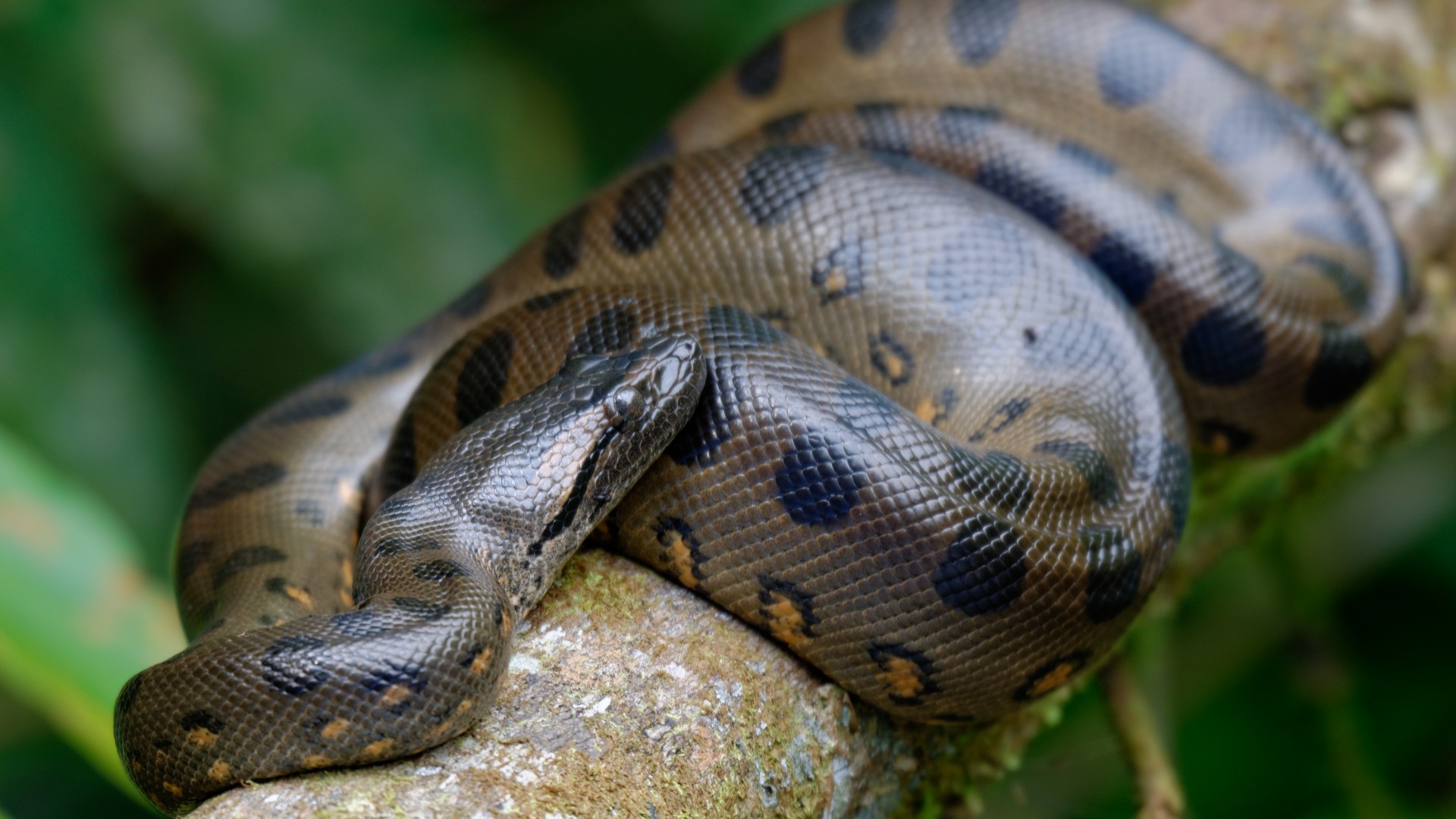
Also called the giant anaconda or the common anaconda, it’s the world’s heaviest snake, easily weighing up to 70 kg on average. It’s also one of the world’s longest snakes, easily able to grow up to 5.21 meters long. The green anaconda fittingly has olive green skin, marked with dark blotches that run down the length of its body. Its head also features a pair of orange-yellow stripes on both sides.
Green anacondas live in South America, across a region stretching east of the Andes Mountains. These include countries like Colombia, Bolivia, Brazil, Ecuador, Guianas, Paraguay, Peru, and Trinidad. They prefer to live near the water, usually in places like swamps and marshes, such as along the Amazon River. Their large size makes them slow and clumsy on land, but green anacondas easily prove deadly fast in the water. In fact, they’re some of the deadliest predators in the region, able to feed on prey as big as deer and capybaras.
That said, while popular media has played them up as man-eaters, only circumstantial evidence actually exists that green anacondas ever preyed on humans. Despite the great threat posed by human development to their native habitats, green anacondas have a surprisingly stable population. This has earned them a Least Concern conservation status.
Indian Python
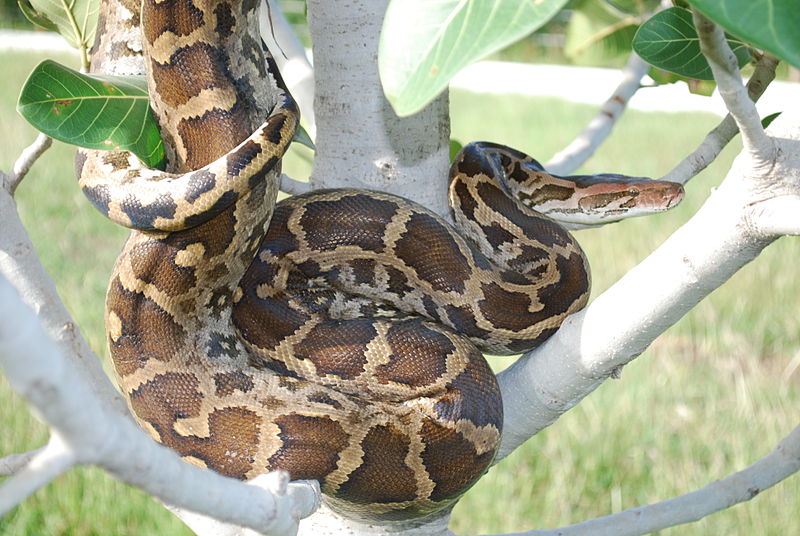
This snake is also called the black-tailed python or the Indian rock python. And as its name, it mostly lives in India. It also has populations in neighboring Bangladesh, Pakistan, and Myanmar. As a python, the snake grows very long, on average around 3 meters, with the longest recorded specimen measuring 4.6 meters long. It has white or yellow skin, marked with blotches of brown or dark brown running down its body.
Indian pythons aren’t aggressive and rarely fight back when attacked, instead preferring to run and hide. This also doubles as their preferred way to hunt, lying in wait before ambushing their prey. Indian pythons once enjoyed a stable population in the 20th century, only to experience a 20% drop in their numbers from 2010 to 2020. Scientists attribute this to the loss of habitat to human development and overhunting of the animals for their skin. This, in turn, gave them the conservation status of Near Threatened.
Indian Rat Snake

Also known as the Oriental rat snake, or darash in Hindi, it’s one of the most common snakes in South and Southeast Asia. They grow fairly large, typically around 1.95 meters long, with the largest recorded specimen reaching a length of 3.7 meters. Ironically, they’re very slim despite their length, averaging a diameter of 6 cm at most. Their color varies depending on where they live, with Indian rat snakes from dry areas having a pale brown color. In contrast, Indian rat snakes from moist areas feature shades of black instead. Indian rat snakes typically feed on small mammals like rats, which contributes to their tendency to live in or near urban areas.
Inland Taipan
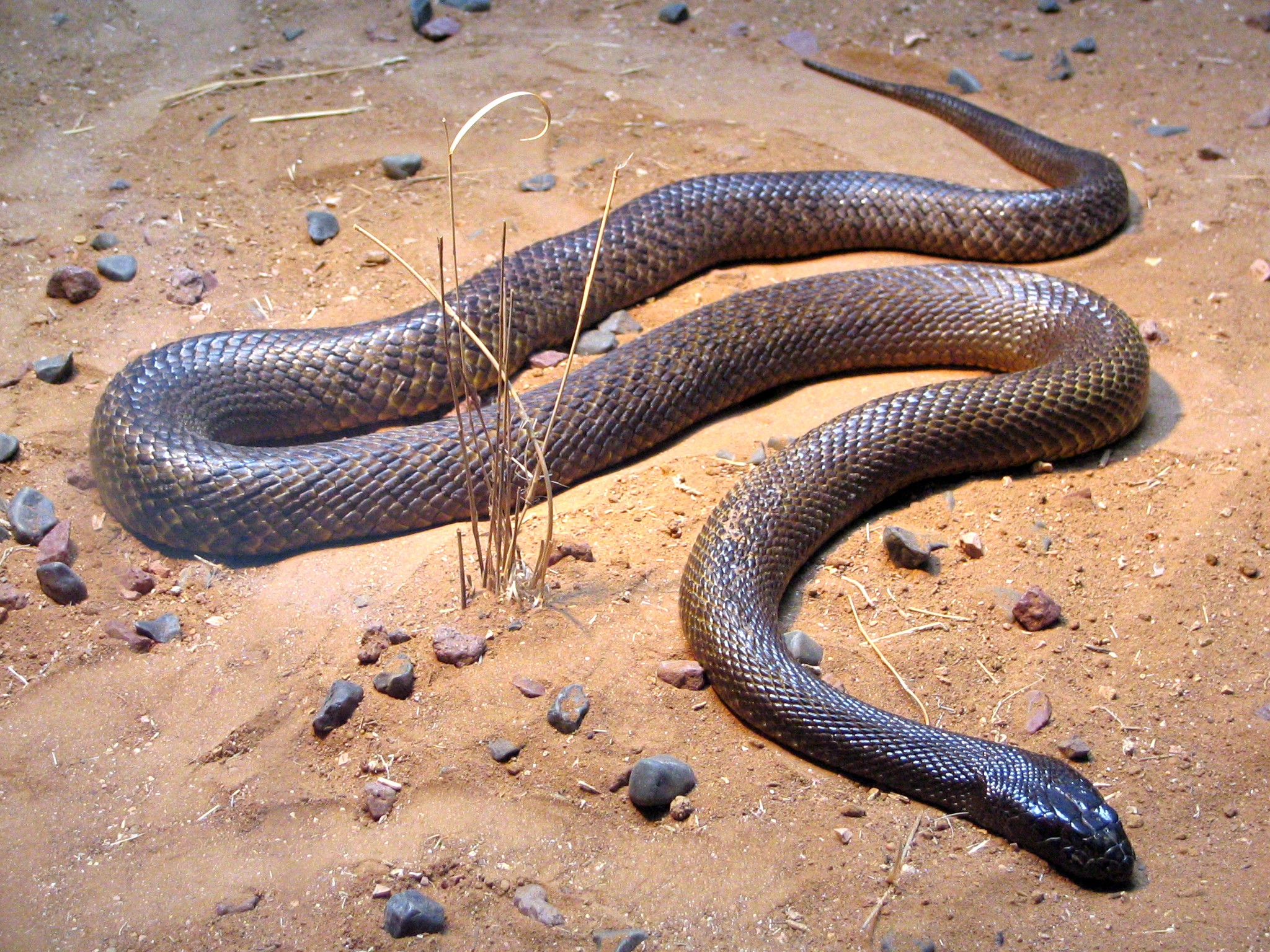
Also called the western taipan or the small-scaled snake, this a venomous snake native to Australia. It’s also the most venomous snake in the world, having specifically evolved to hunt and kill mammals. In fact, a single bite’s worth of venom from the inland taipan can kill up to a hundred people. It’s also very aggressive, biting its victims multiple times, with an 80% fatality rate without immediate medical attention.
That said, the inland taipan also has a reclusive character, and will only bite if necessary. Otherwise, it prefers to run and hide. Inland taipans tend to either have dark-colored or light green skin, with black-shaded scales on their sides and tail. Their skin also shifts in tone with the seasons, growing lighter in summer and darker in winter.
Inland taipans typically grow up to around 1.8 meters long, with some specimens able to reach lengths of up to 2.5 meters. The snake has an overall Least Concern conservation status, however, it has also become extinct in parts of its range, such as Victoria state in Southern Australia.
King Cobra
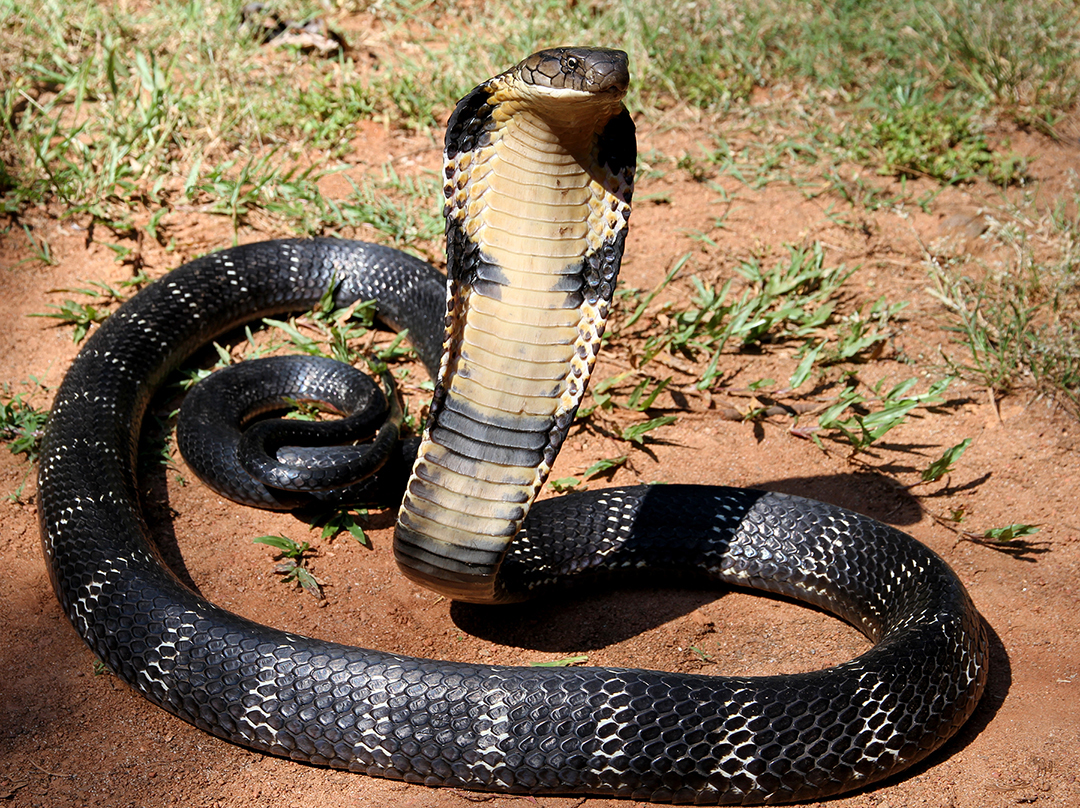
Arguably the most famous snake of them all as it’s usually the animal that comes to mind when people hear the word “snake”. It’s also the longest venomous snake in the world, averaging around 4 meters long, with some specimens growing up to 5.85 meters long. Its color varies from black with white stripes, to a uniform brown-gray. It’s most known for its neck flaps, though, which the snake spreads as part of an aggression display to warn other animals from coming closer.
Despite its reputation, king cobras actually avoid humans whenever possible. It also rarely feeds on mammals or non-reptiles, with other snakes serving as its usual prey. When biting its prey, the king cobra has a habit of holding its fangs in the prey’s flesh for as long as possible. It does this to inject as much venom as it can to guarantee a clean kill. This, however, greatly complicates providing medical care to humans bitten by a king cobra. It also adds to the animal’s lethal reputation, which has made it symbolic of destruction in Hindu mythology.
That said, this has also earned it the distinction of India’s national animal. Ironically, the species currently suffers from limited protections, despite having gained a Vulnerable conservation status thanks to the loss of its habitat to human development.
Malayan Pit Viper
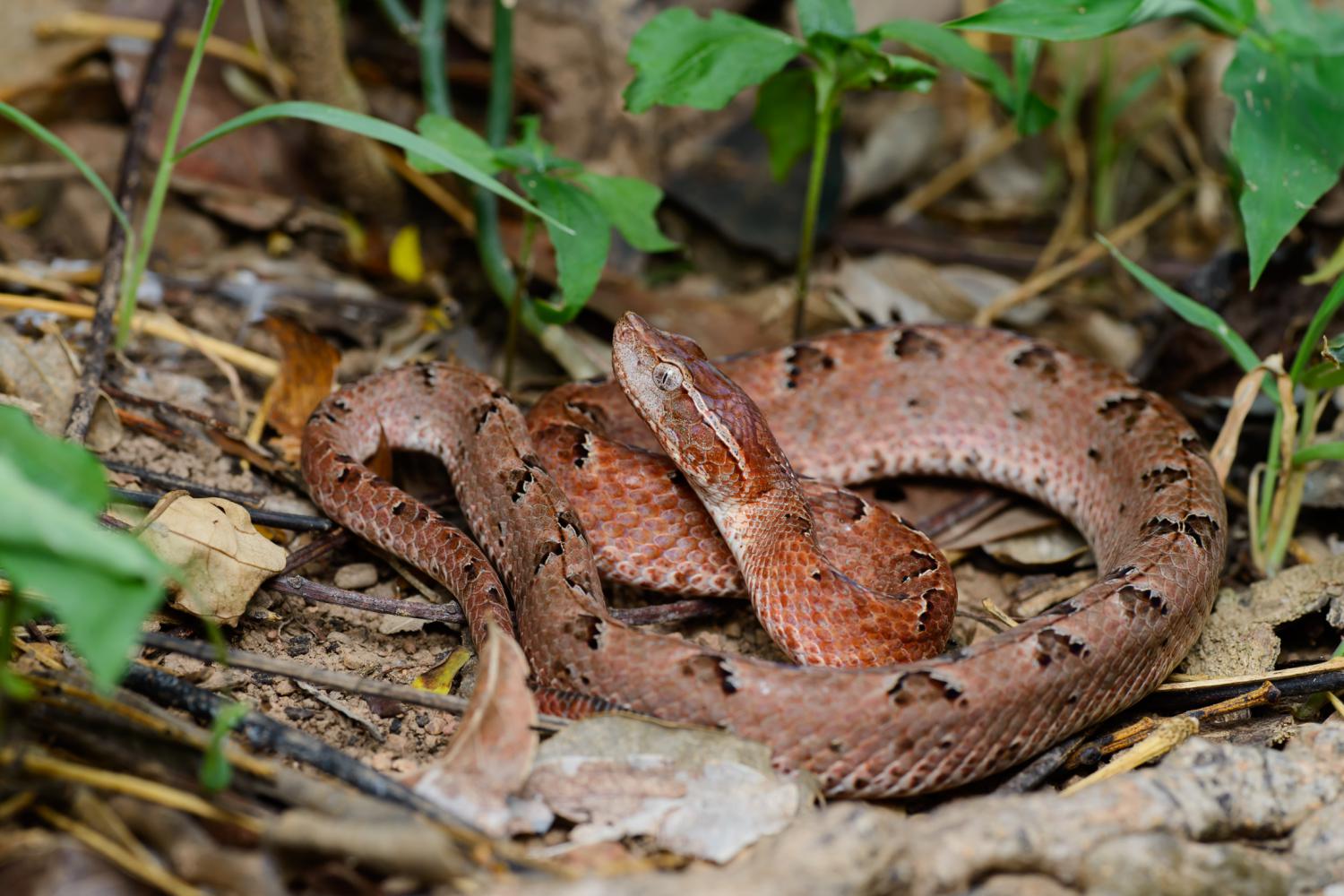
As its name indicates, the Malayan pit viper lives in Malaysia, although it also ranges north into Thailand. It also has a presence in Indonesia, Laos, and Nepal. This wide range of habitats allows the snake to maintain a stable population, and with it, the Least Concern conservation status.
Malayan pit vipers typically grow up to 76 cm long, with rare specimens growing up to 91 cm long. Its skin usually has a brown, gray, or red color, along with either alternating or opposing rows of blotches. These blotches have a dark brown color, along with black edges. In contrast, a Malayan pit viper’s belly has a yellow color, with gray or brown spots.
It’s also quite aggressive, with Malaysia alone reporting an estimated 700 bites per year. Thankfully, the venom isn’t that virulent, with a fatality rate of only 2% with immediate medical attention.
Mexican Milk Snake
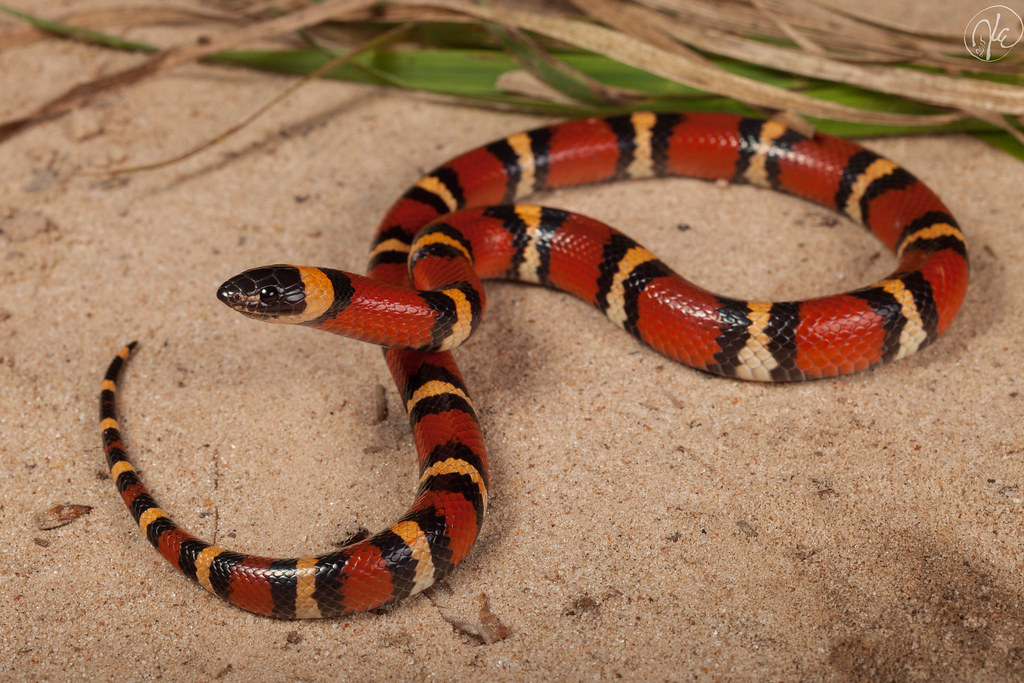
As its name indicates, this non-venomous snake mostly lives in Mexico, and can also be found north into the Southern USA. It’s also fairly short compared to other milk snakes, only growing up to 70 cm long at most.
It also has similar coloring to the venomous coral snake, often causing non-experts to mistake the two. Specifically, the Mexican milk snake has alternating bands of red, black, and white running down its body. In contrast, coral snakes have alternating bands of red, yellow, and white, which experts point out makes for a simple way to differentiate the two snakes.
The Mexican milk snake usually eats small mammals and reptiles and has a docile temperament. The latter, in particular, has made it a favorite among exotic pet owners around the world.
Montane Pit Viper
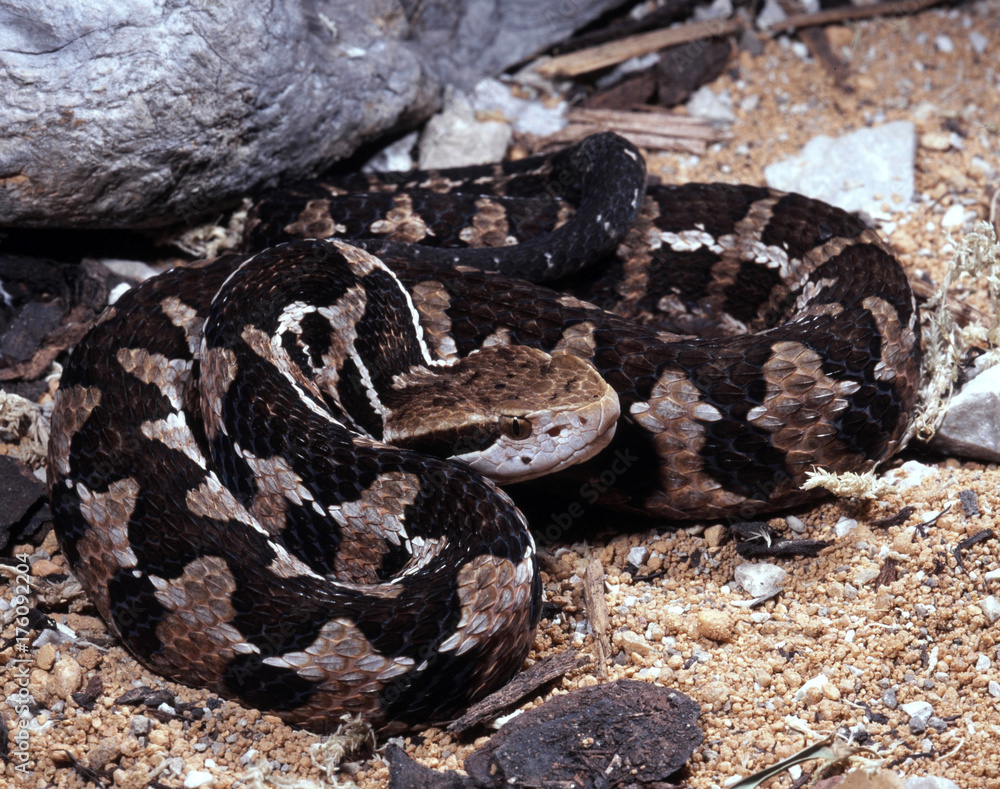
Also called Godman’s pit viper, it takes its common name from its usual habitat: forested regions along mountainsides. Its alternative name honors the 19th century English zoologist Frederick Godman. The Montane pit viper mostly lives in Southern Mexico, with their habitats also covering south into Guatemala.
They are fairly short snakes, usually growing only up to around 55 cm long, with some specimens able to grow up to 75 cm long. They mostly have a black color along with a zigzagging stripe going down their backs. However, the snake’s head has a rust-red color instead. While a venomous snake, its venom isn’t particularly dangerous, with only the current lack of an antivenom complicating any medical care after a bite.
Night Adder
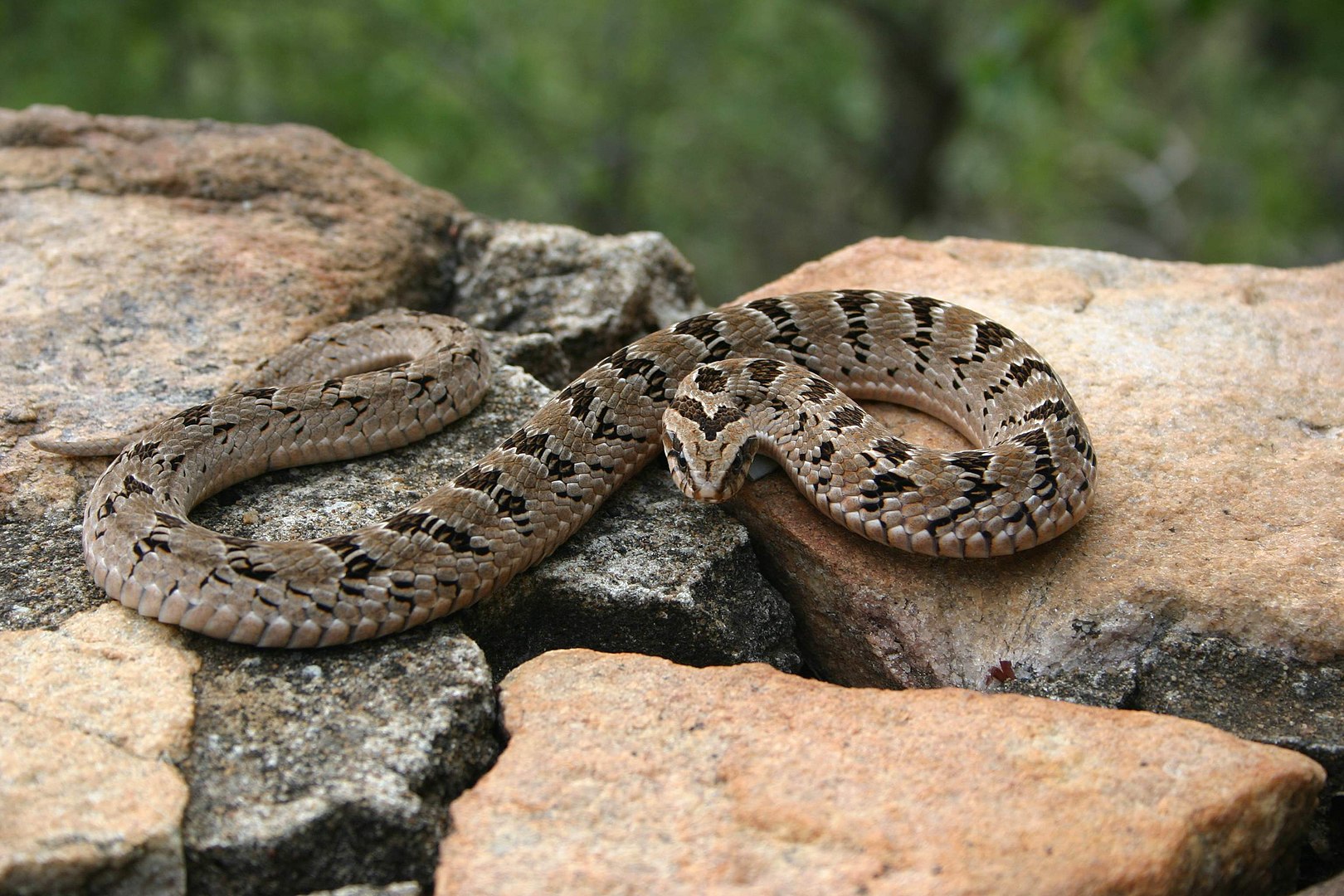
Also called the rhombic night adder, this venomous snake lives all over the sub-Saharan region of Africa. It’s a fairly short snake, usually growing up to only 60 cm long, with some specimens able to reach a length of 93 cm. The snake can also move rather quickly, with speeds of up to 92 cm per second.
The night adder usually has an olive green color, but some snakes have a black color instead. It also features a pattern of white-edged rhombuses going down its body, from which it gets its name. Its head also features a distinctive V-shaped mark in brown with a black outline. While poisonous, the night adder isn’t particularly deadly, with no recent records of fatalities given immediate medical care.
Olive Sea Snake
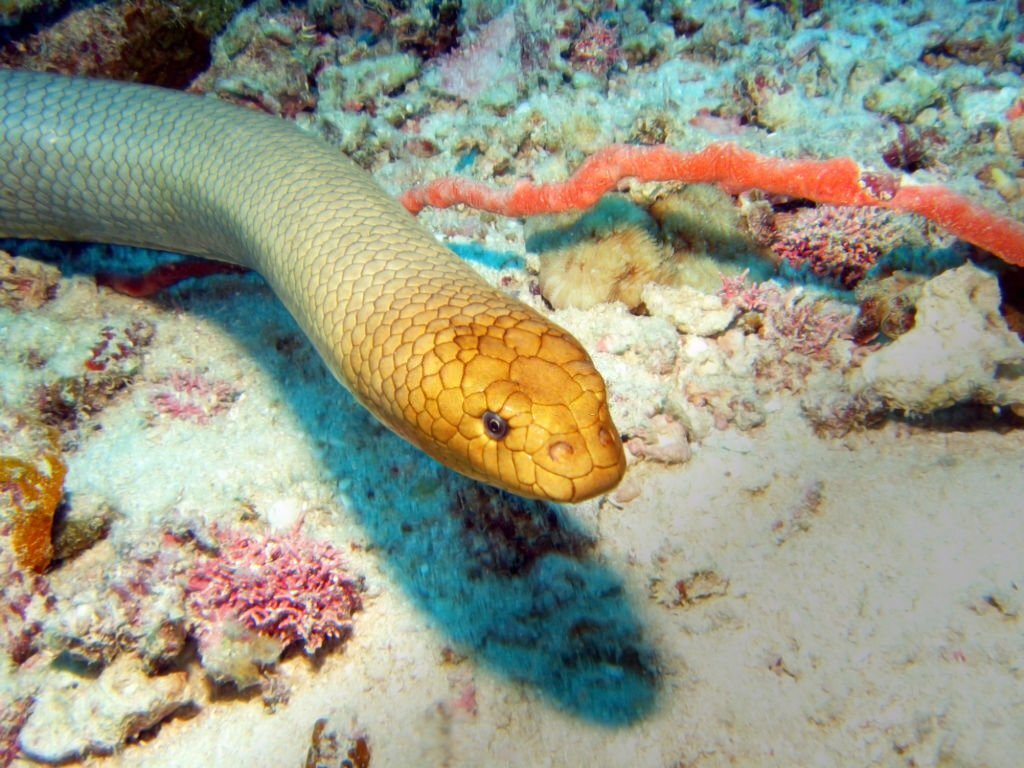
Also called the golden sea snake, it spends all its time underwater where it lives in coral reefs. Ironically, its name doesn’t actually reflect its appearance, as it mostly has a brown or violet color contrasting with its pale belly. It can grow quite long, though, with most adults measuring over a meter in length, and the longest recorded specimen measuring 2 meters long.
It’s also the most venomous sea snake of them all, with a powerful venom that literally digests the prey from the inside out. Scientists think the olive sea snake evolved this way to better digest its food. That said, the olive sea snake isn’t particularly aggressive and tends to avoid larger fishes and even divers. However, it can and will attack when provoked, leading experts to advise divers to avoid coming near the snakes.
Palm Pit Vipers
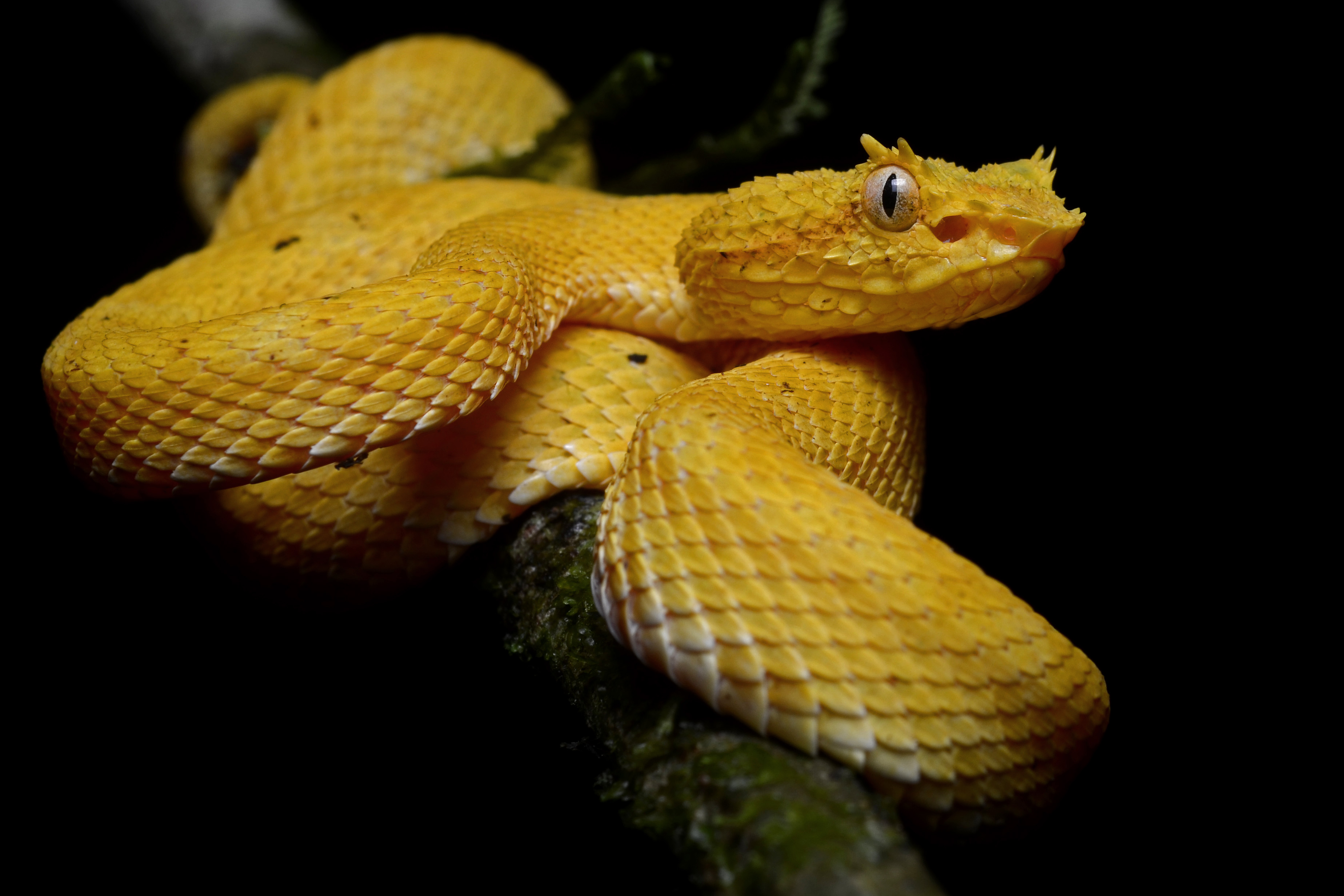
Also called the eyelash viper, this venomous snake lives across Central and South America. It gets its common name from its habit of hiding around palm trees while waiting for prey. Similarly, its alternative name comes from the unusual arrangement of scales around its eyes, which give the impression of eyelashes.
Palm pit vipers have a short length for vipers, usually only growing up to around 88 cm long. Their skin comes in various colors: from brown, green, pink, and red to yellow. They may also have brown or black speckles on their scales.
Palm pit vipers have not received conservation status, as no international organization has formally assessed the stability of their population. Despite this, scientists worry that deforestation, human development, and poaching have posed serious threats to the future of the species.
Picado’s Jumping Pit Viper
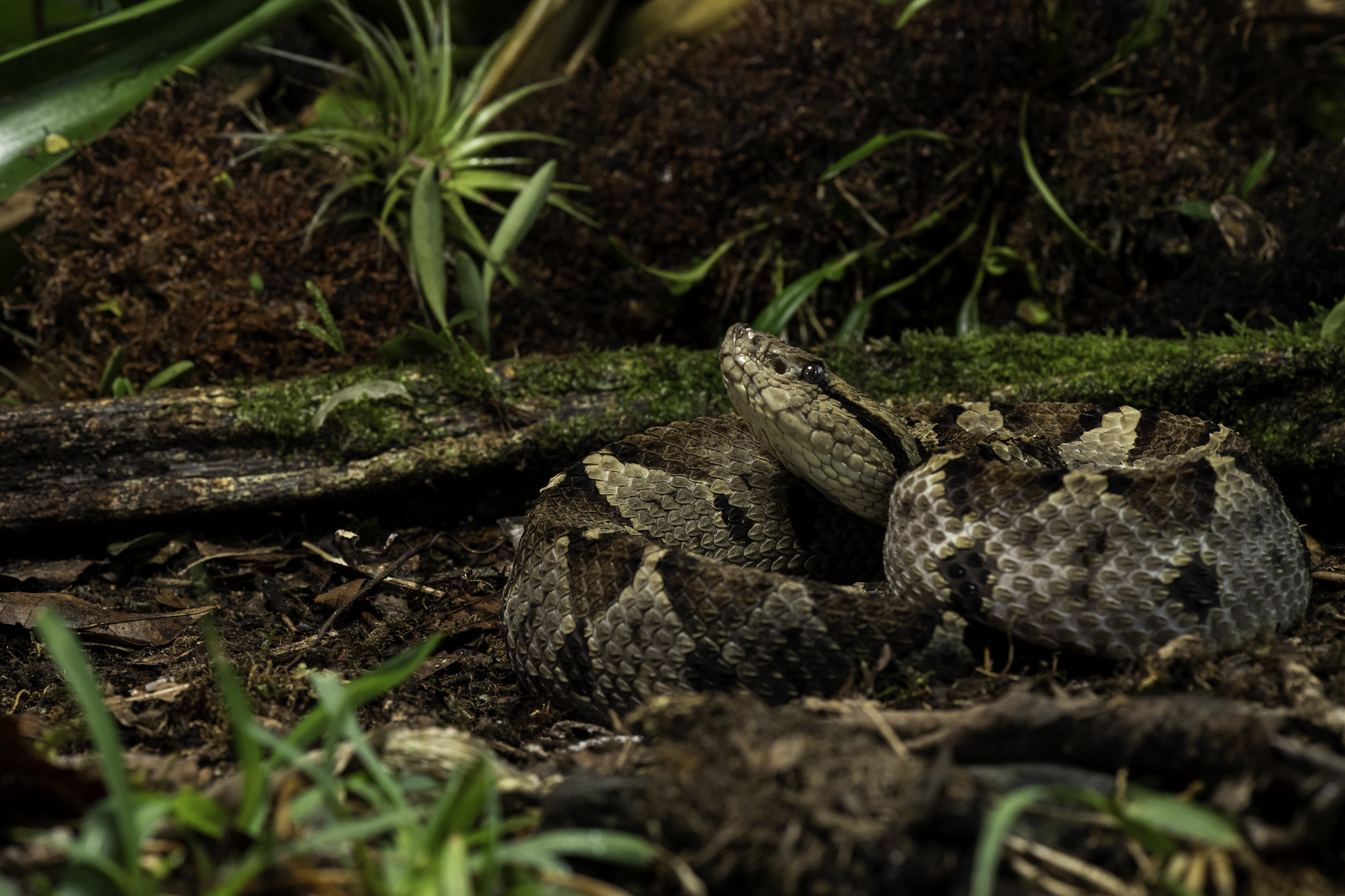
A snake native to Central America, it takes its name from Costa Rican herpetologist Picado Twight. Its name also refers to how it can strike so energetically, as the snake literally jumps off the ground when it does so. It lives in the mountainous regions of Costa Rica and Western Panama, at altitudes between 50 meters and 1.5 km above sea level.
The snake grows up to 95 cm long, with the longest recorded specimen measuring 1.2 meters long. Its skin has a brown or gray color, along with diamond-shaped markings going down its back. While venomous, medical experts note that Picado’s jumping pit viper’s venom isn’t particularly dangerous if the victim is given immediate medical attention.
Red Milk Snake
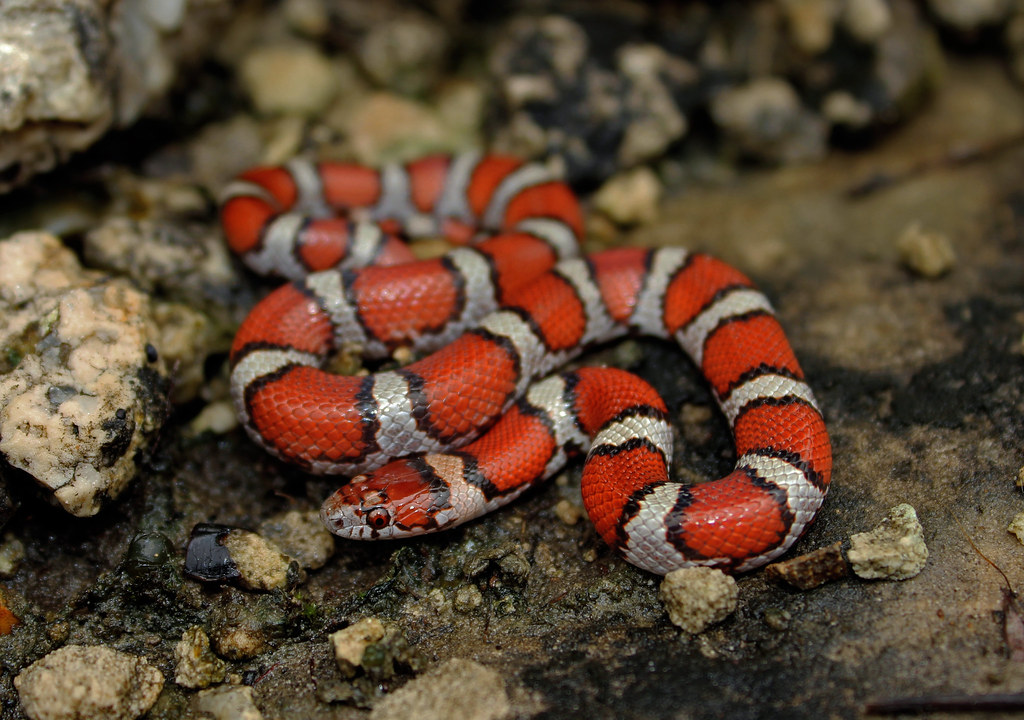
A non-venomous snake native to North America, where it ranges across the Central USA. They typically grow up to around 91 cm long, with the longest recorded specimen measuring around 132 cm long.
Its skin mostly features alternating bands of white and red with black edges. Some specimens also feature unusual color variations, such as red-brown or gray-brown instead of red. The snake’s bright and vivid colors often frequently get it mistaken for a venomous snake. Its belly, though, contrasts with the rest of its skin, with a white color broken up by a black checkerboard pattern. A red milk snake’s head also features a distinctive red blotch with black edges.
Reticulated Python
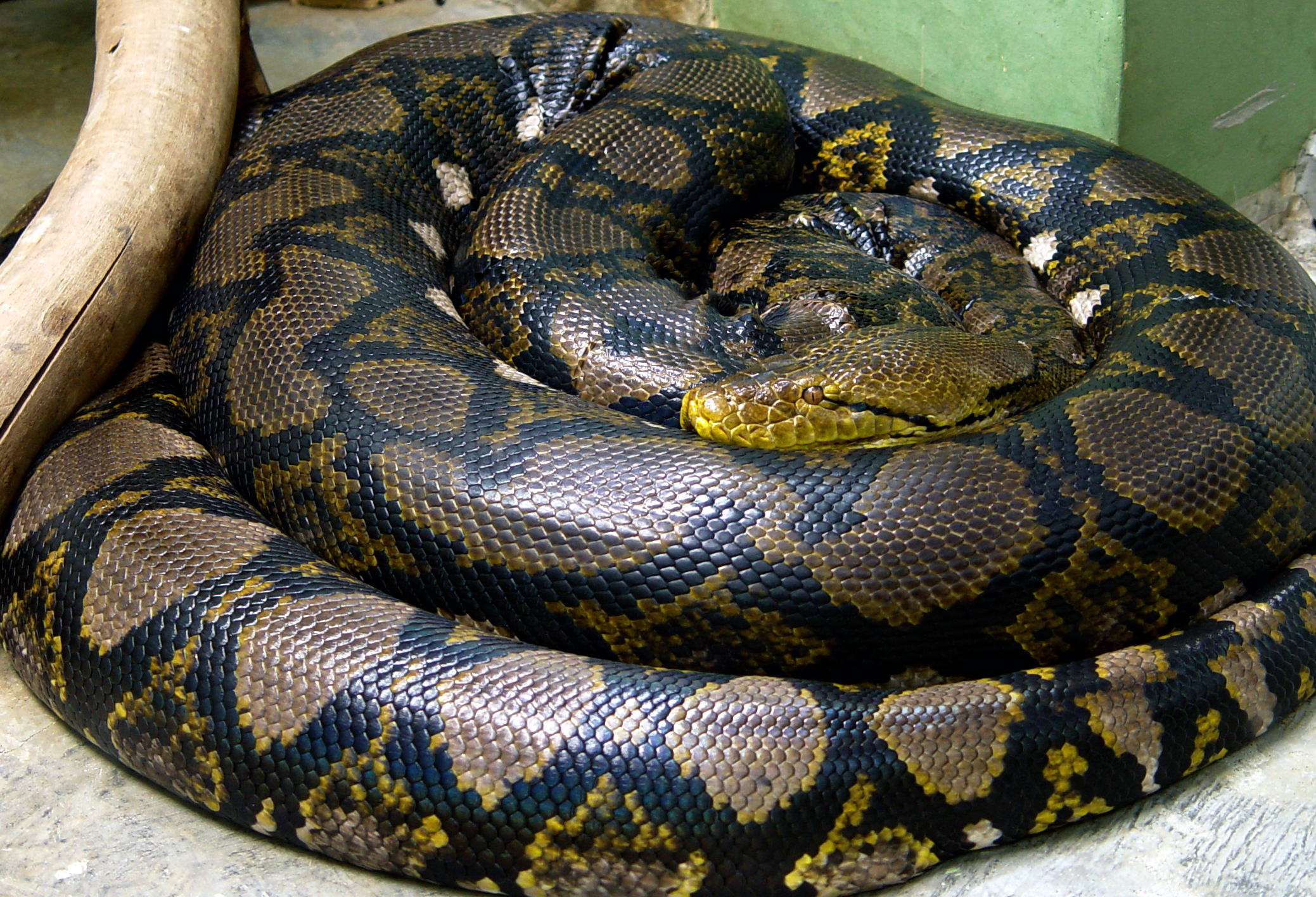
The longest snake in the world, the reticulated python has a widespread presence across South and Southeast Asia. In particular, while it prefers to live on land, the snake swims very well, which scientists think allowed it to spread to islands across the region.
The reticulated python grows up to an average of 6.5 meters long, with the longest recorded specimen measuring 6.95 meters long. It’s also one of the world’s heaviest snakes, on average measuring a maximum weight of 75 kg. The snake also features one of the most complex color schemes in the animal kingdom. Scientists describe it as a multicolored series of irregular diamond shapes that actually form a complex geometric pattern. Also called disruptive coloration, it’s a form of natural camouflage that makes the snake practically invisible in the wild.
The reticulated python also counts as one of the few snakes confirmed to hunt and feed on humans. The USA actually banned the import of the animal in 2015 given its long history of deliberately preying on humans. Ever since then, at least three confirmed cases exist of a reticulated python eating a human. All of them took place in Indonesia, first in 2017, then again in 2018, and finally in 2020.
Ribbon Snake
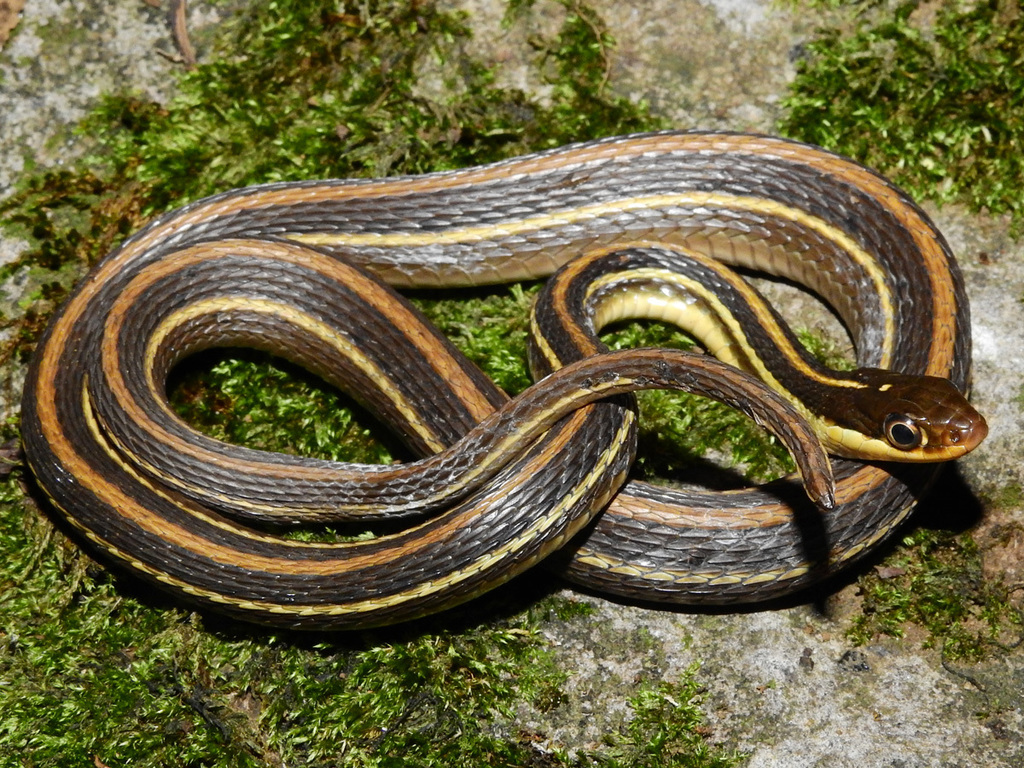
A small snake native to North America, the ribbon snake lives across the Eastern USA. At most, they grow up to 85 cm long, with dark brown skin marked by yellow stripes. They prefer to live in wetlands with plenty of vegetation, such as marshes near lakes, ponds, and streams. While this makes them good swimmers, especially when hunting for food, ribbon snakes prefer to live on dry land.
Ribbon snakes usually feed on small amphibians and reptiles, such as frogs, newts, salamanders, and toads. They also feed on invertebrates, such as earthworms and spiders. These snakes also tend to have timid dispositions, and would sooner run and hide rather than bite bigger animals.
Ring-Necked Snake

A somewhat controversial type of snake, the ring-necked snake has a widespread population across Canada, the USA, and Mexico. The controversy over the snake comes from the limited research done on the species. In particular, the ring-necked snake supposedly has 14 subspecies, but many scientists contest this over what they see as insufficient research.
The ring-necked snake takes its name from a ring of red, yellow, or yellow-orange color around its neck. Its back typically has a gray or olive color, which contrasts with the red or yellow-orange color of its belly. The belly also typically features crescent-shaped markings in black along the sides. A ring-necked snake’s head also usually has a darker color than the rest of its body.
Ringed Water Cobra
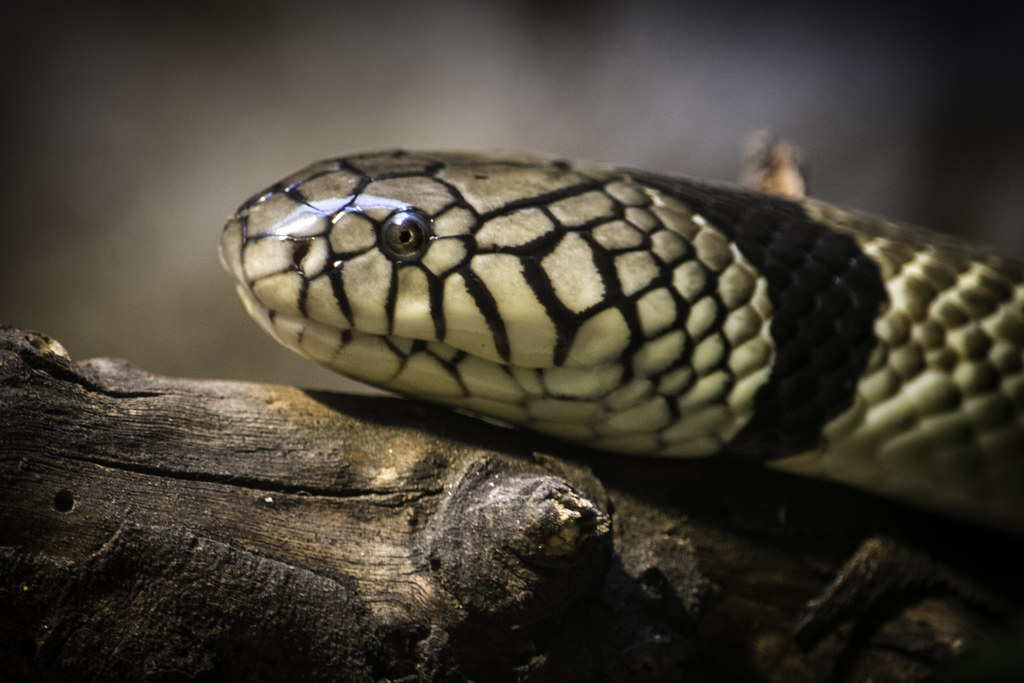
Also called the banded water cobra, this venomous snake mostly lives in Central Africa, and is also found in parts of West Africa. A very long snake, it usually grows up to around 2.2 meters long, with the longest recorded specimens growing up to 2.8 meters long. Its skin tends to have a glossy brown, red-brown, or gray-brown color with black bands running down its body. The skin also darkens towards its tail, which has a solid black color. The snake’s belly also contrasts with the rest of its body, with a pale yellow color.
As its name indicates, the ringed water cobra likes to stay in the water, with the ability to stay underwater for up to 10 minutes. In fact, the snake tends to move slowly when on land, and will usually hide instead. It mostly feeds on fish, as well as on amphibians like frogs and toads. The ringed water cobra tends to avoid humans, meaning bites, fortunately, occur rarely. Studies into the snake’s venom have remained limited, but the studies that exist point to the ringed water cobra having powerful and long-lasting neurotoxin-based venom.
Taylor’s Cantil
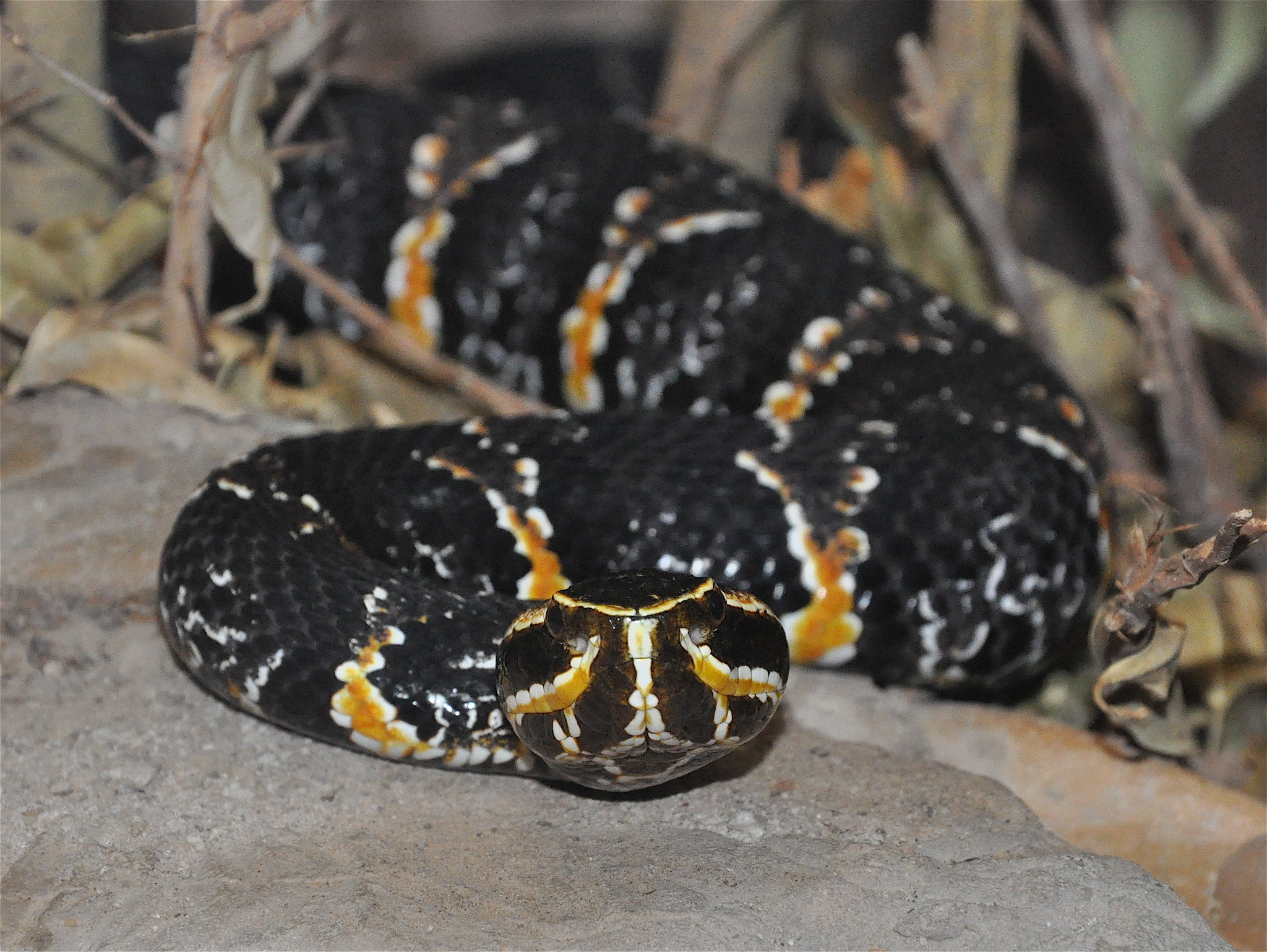
This venomous snake takes its name from Dr. Edward Taylor who conducted major studies on Mexico’s amphibian and reptilian life. Taylor’s cantil has a fairly large size, growing on average to around 90 cm long. Their bodies feature black or gray-brown bands separated by narrow stripes of orange, white, or yellow. Males of the species also tend to darken with age, with many elderly specimens having a black color.
Taylor’s cantil usually avoids humans but becomes very aggressive when approached. That said, no records currently exist of humans ever dying from a bite by Taylor’s cantil. Taylor’s cantil has a complicated conservation status, with international organizations listing it as Least Concern. However, the Mexican government disagrees and has officially listed the species as Threatened.
Toadhead Pit Viper

Also called Campbell’s toad-headed viper, or the Ecuadorian toad-headed pit viper, this venomous snake lives in South America. It typically grows up to around 105.7 cm, with the longest recorded specimen measuring up to 121.9 cm long. The snake is brown, marked with faint, trapezoid-shaped blotches that run down its body. Younger specimens tend to have brighter blotches than adults and also feature red-brown tails.
They currently have a Vulnerable conservation status, which results from the loss of habitat due to human development. Other threats to them include hunting by humans. Ecuadorian records also point to a number of snake deaths as a result of vehicle impacts.
Western Diamondback Rattlesnake
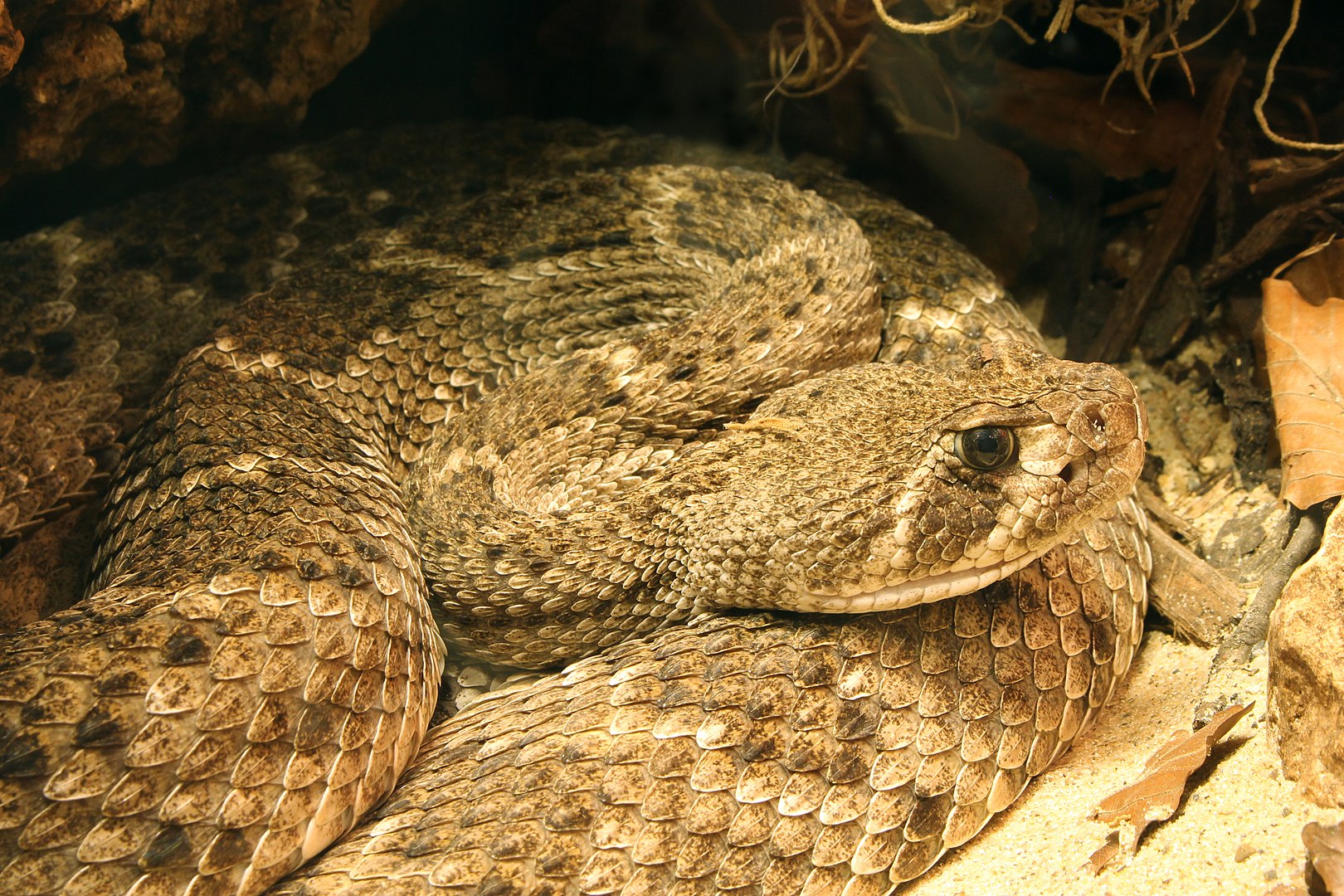
The most infamous snake in the USA, largely due to snakebites in the country caused by it. This, despite the fact that it lives only in the southwestern states, as well as in neighboring Mexico. Its venom features a powerful hemotoxin that not only destroys the blood but also damages blood vessels and even the heart. It also causes secondary effects that both damage muscle tissue and retards cellular regeneration. In fact, internal bleeding makes up a dangerous symptom of western diamondback bites that can prove fatal.
Western diamondbacks typically grow up to 1.2 meters long, with the longest recorded specimen measuring up to 2.13 meters long. They also usually feature a dusty, gray-brown color that helps them blend into the ground. This also makes them quite dangerous, as people don’t see they’re walking up to a dangerous and venomous snake until it’s too late. Western diamondbacks also have dark, gray-brown, or brown blotches running down their bodies. These blotches start out with rectangular shapes near the head, before shifting to hexagonal and finally diamond shapes. These serve as the origin of the snake’s name.
Was this page helpful?
Our commitment to delivering trustworthy and engaging content is at the heart of what we do. Each fact on our site is contributed by real users like you, bringing a wealth of diverse insights and information. To ensure the highest standards of accuracy and reliability, our dedicated editors meticulously review each submission. This process guarantees that the facts we share are not only fascinating but also credible. Trust in our commitment to quality and authenticity as you explore and learn with us.
